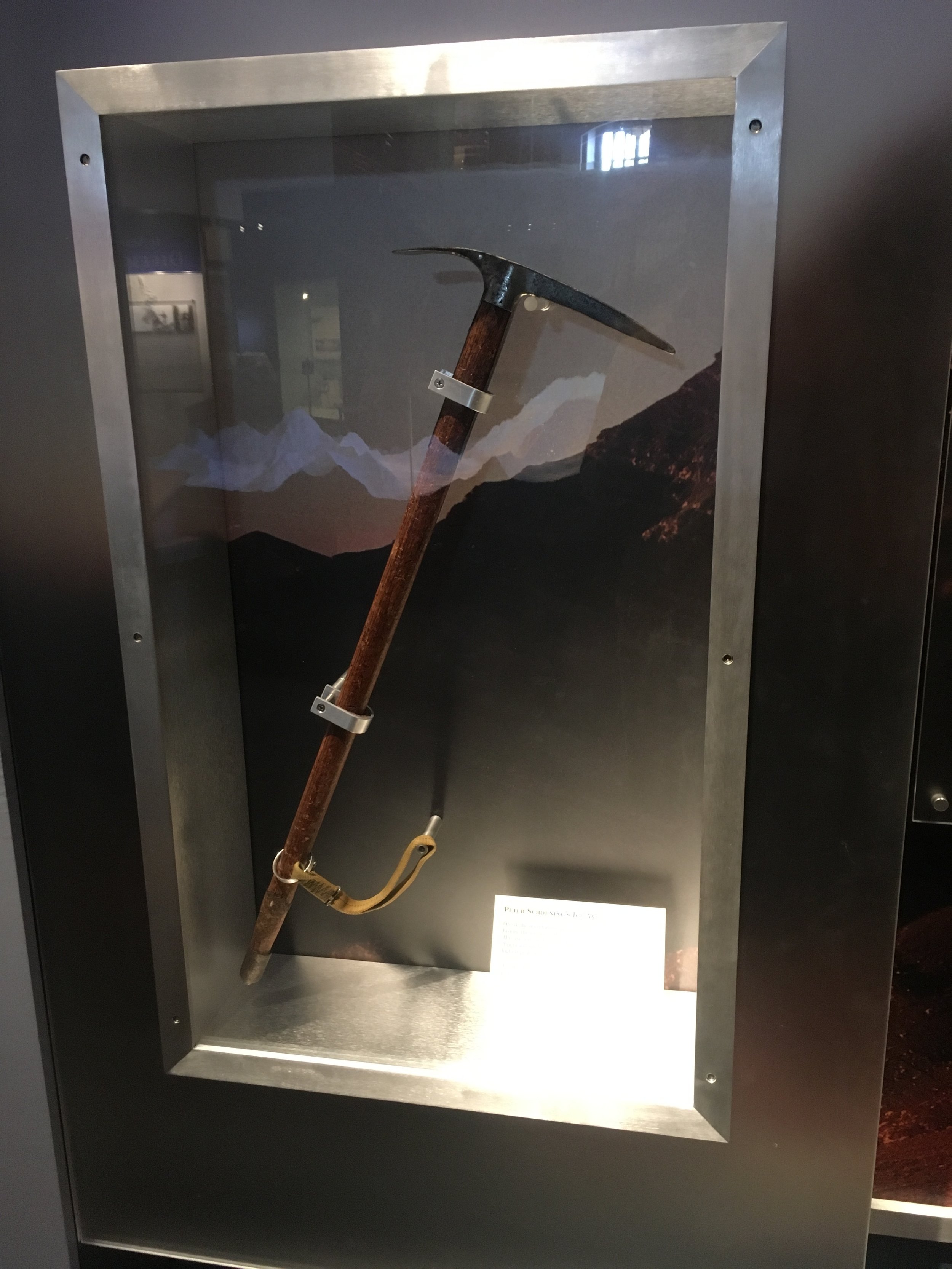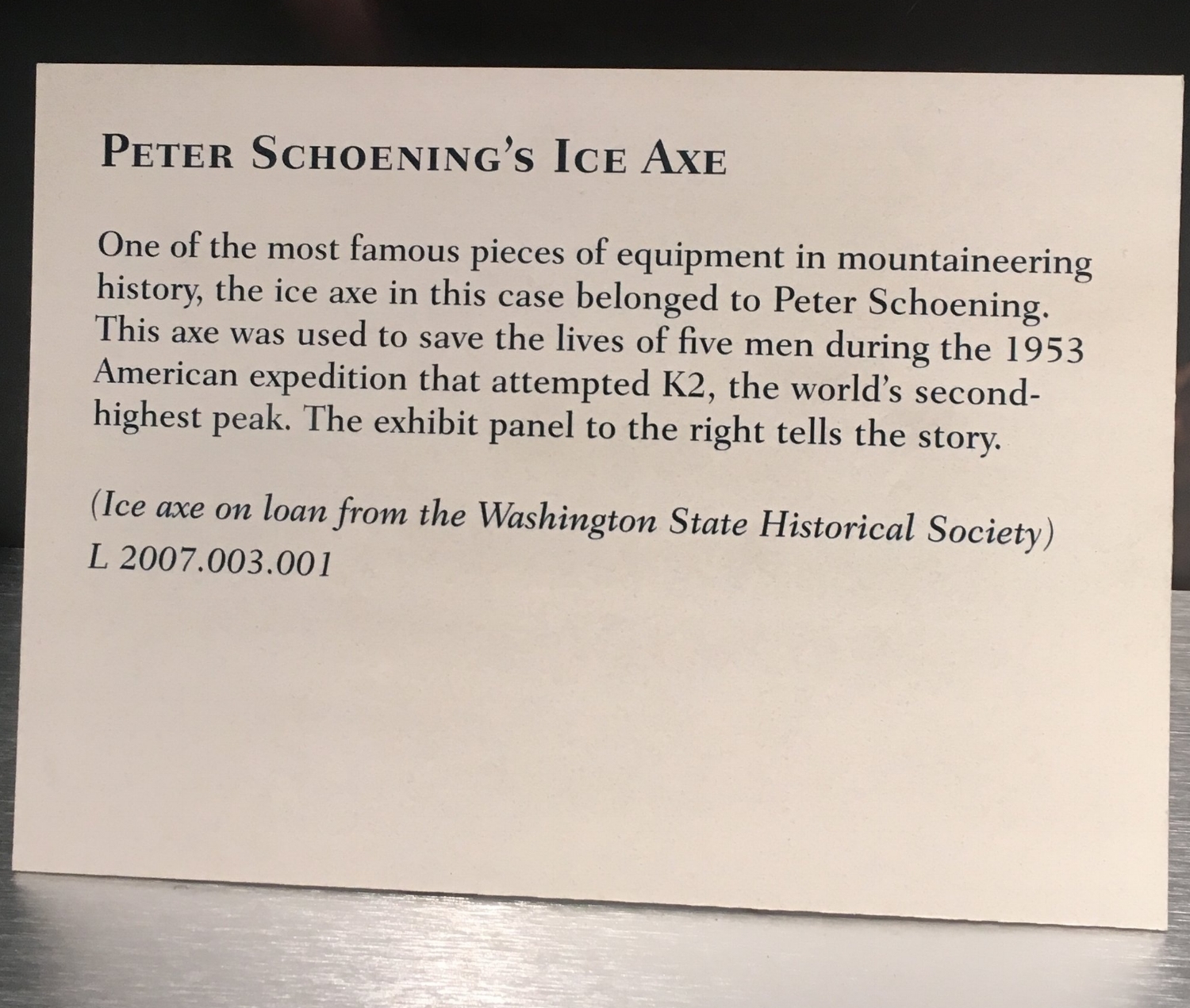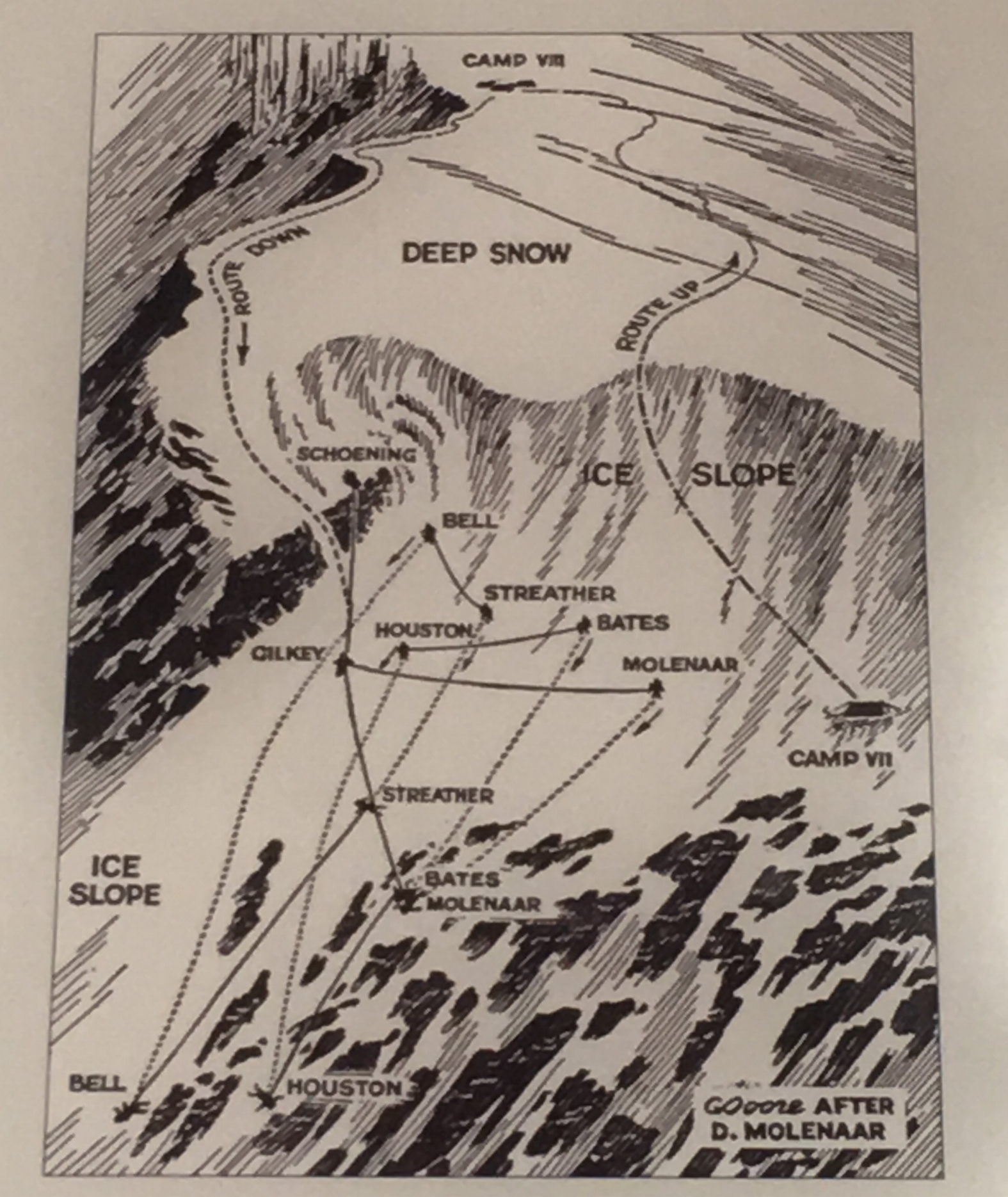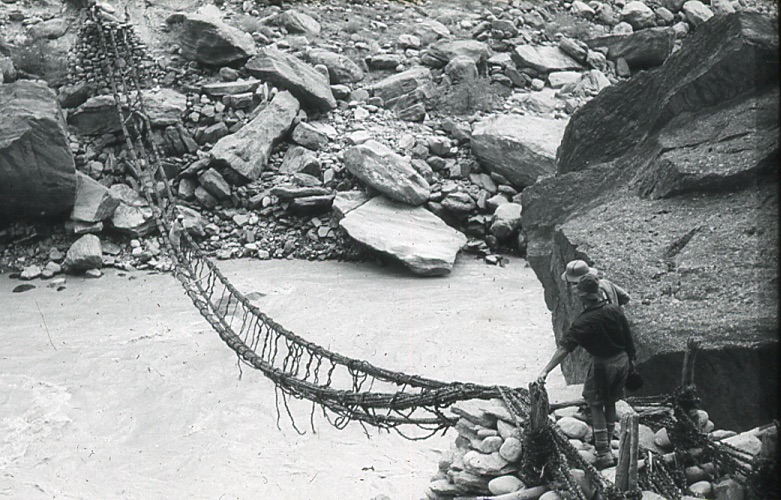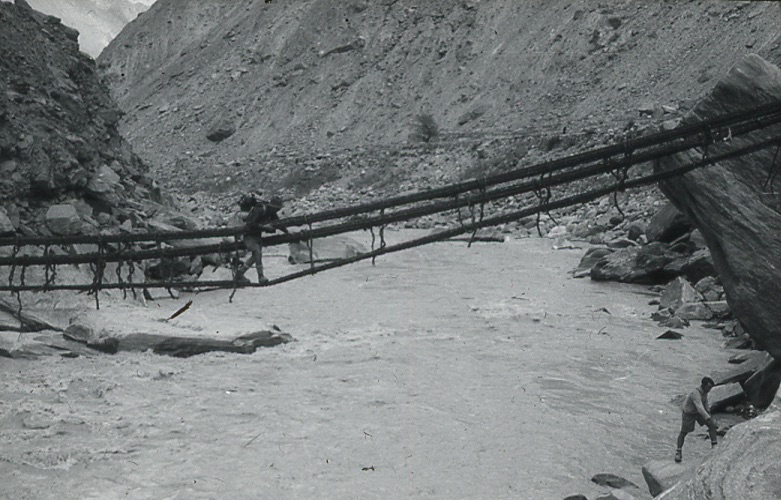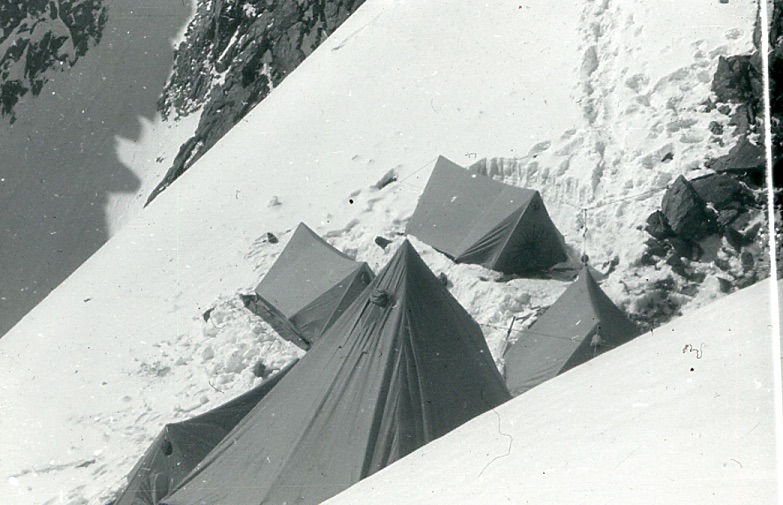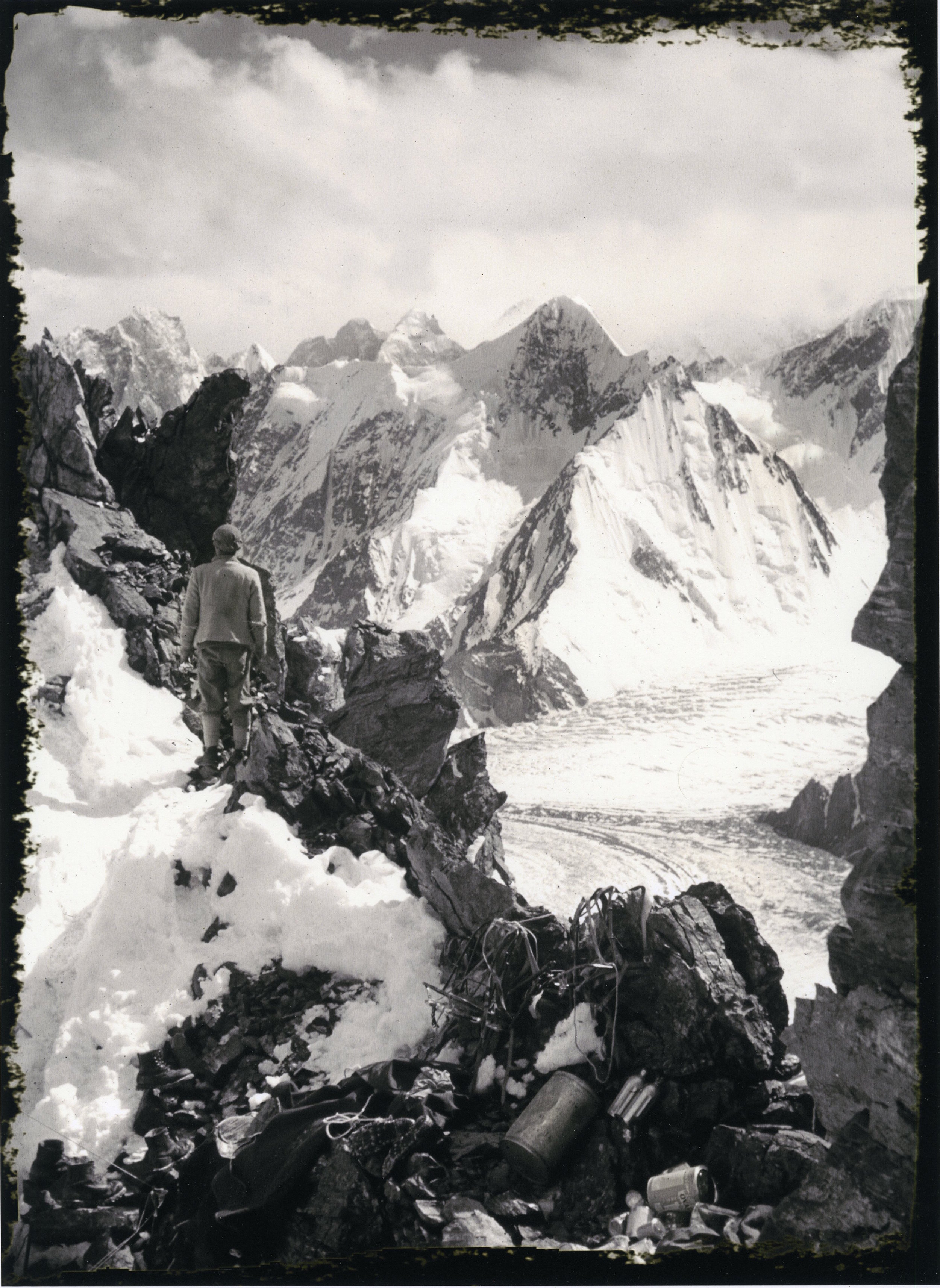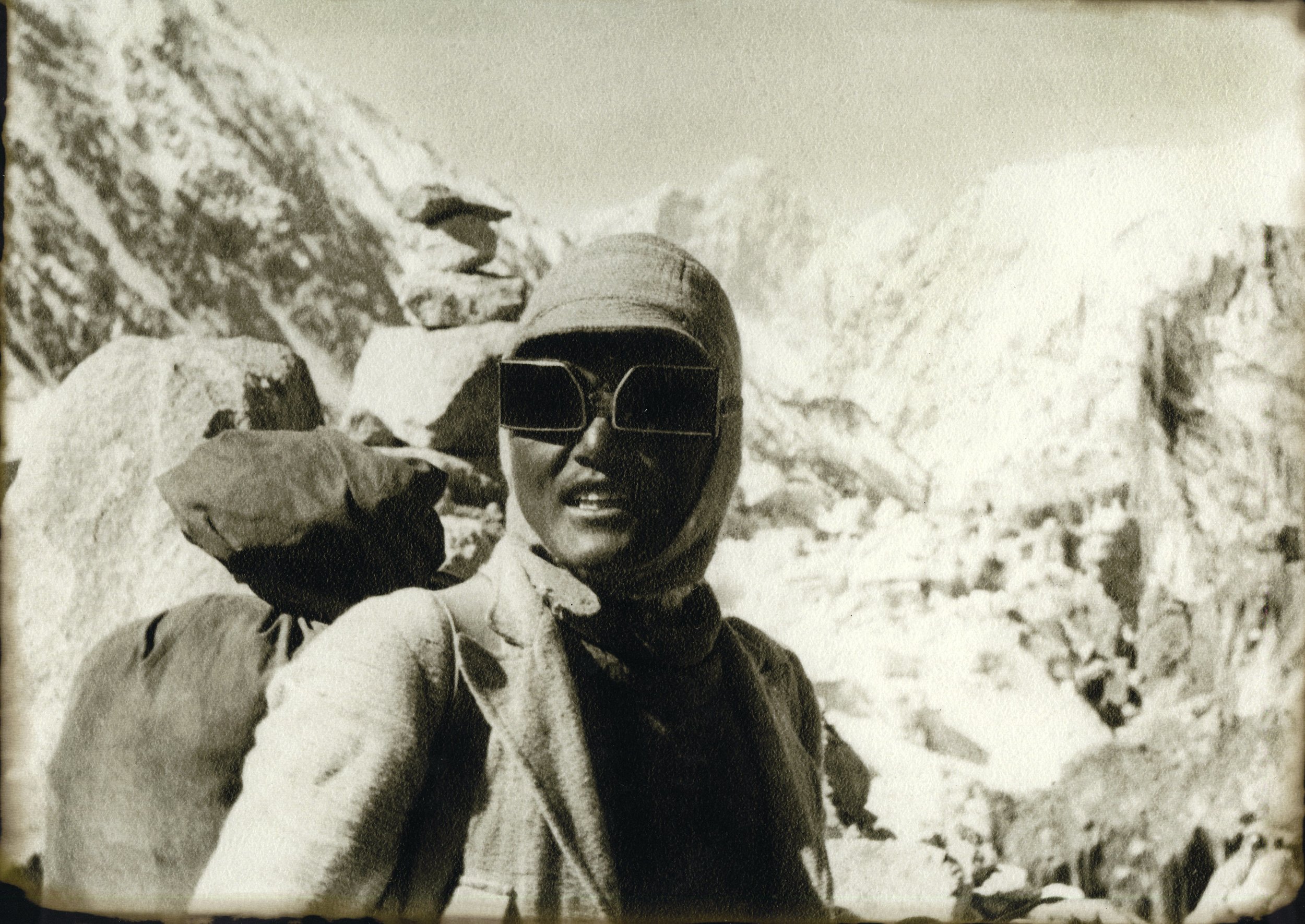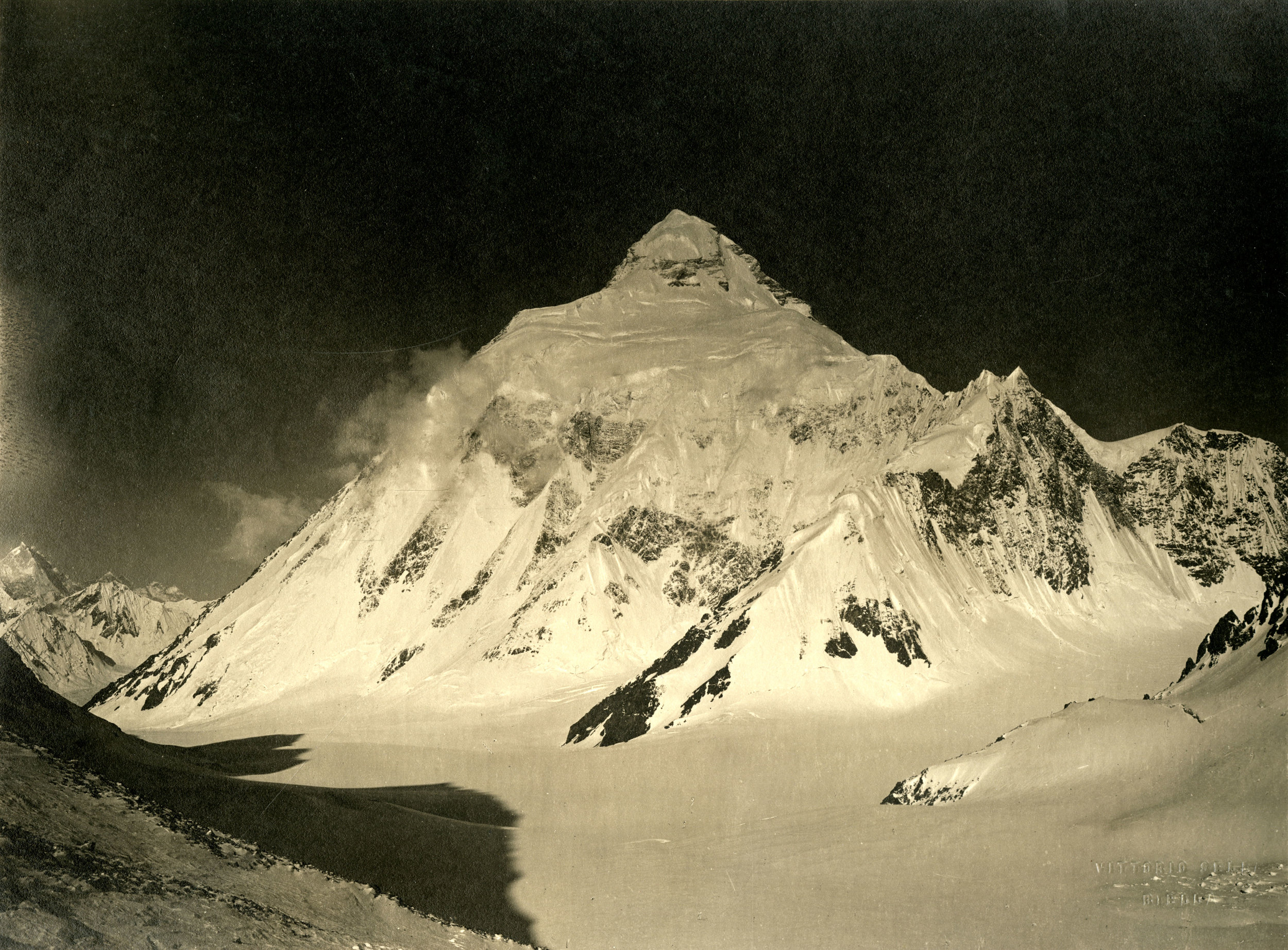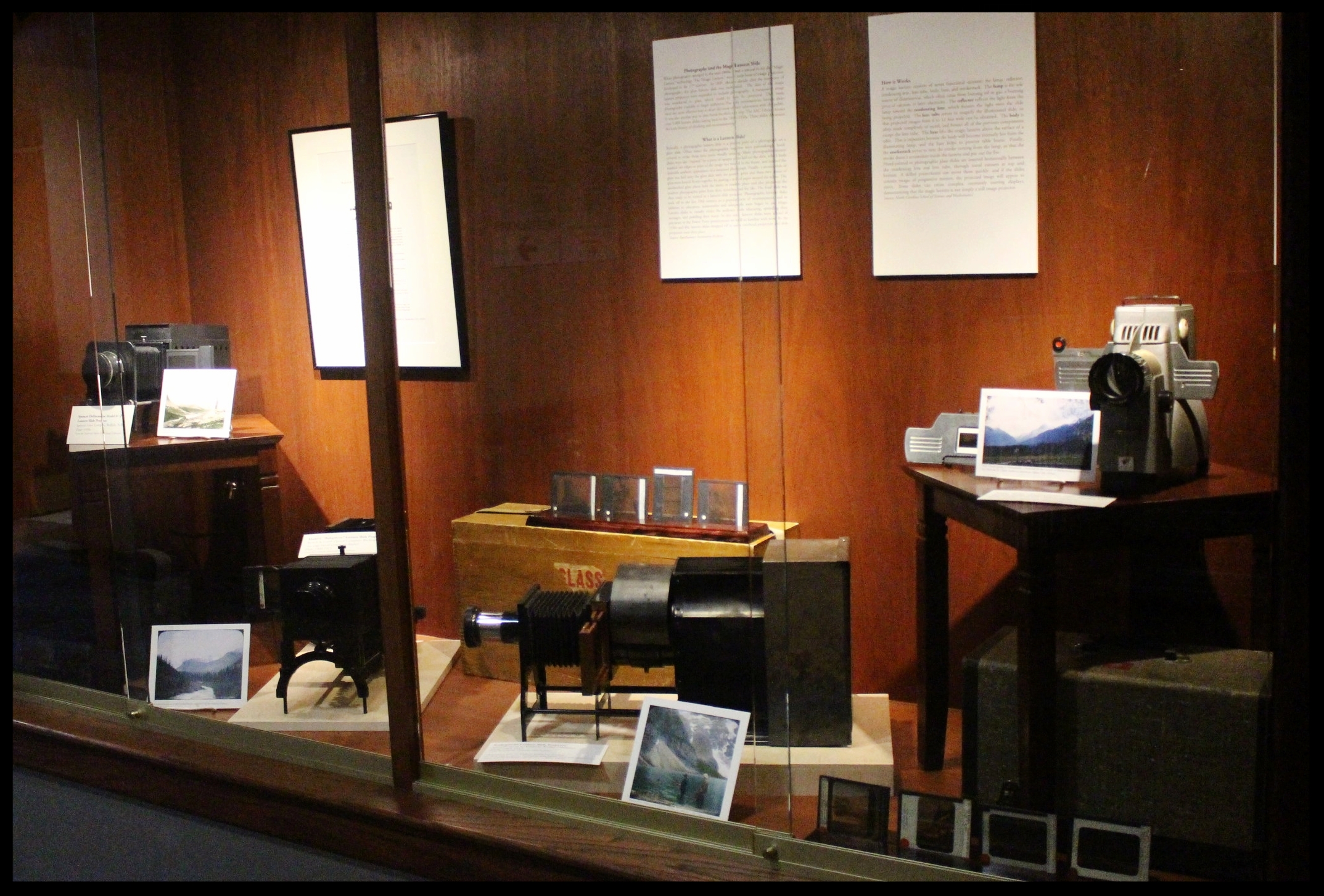In 1925 Albert H. MacCarthy had just led a successful first ascent of Mount Logan in Canada, composed of climbers from Canada, Britain and the United States. MacCarthy, an American and member of the American Alpine Club, wrote a number of reports and summaries of the expedition, including this list of Mountain “Dont’s.”
K2 1953: The Third American Karakoram Expedition
by Eric Rueth
Camp V (22,000 ft.) with Mashrabrum [sic] in the background. Photo, Third American Karakoram Expedition.
For the third and final installment of our pre-2018 Annual Benefit Dinner Americans on K2 wrap-up, we’ll take a look at the Third American Karakoram Expedition in 1953. It doesn’t seem possible to start this blog post better than the way Robert Bates started his article about the expedition in the 1954 American Alpine Club Journal,
“On 2 August 1953 all eight members of the climbing party of the Third American Karakoram Expedition, in excellent physical condition, were camped at 25,500 feet on K2 with ten days’ food. The summit of the second highest mountain in the world (28,250 ft.) rose less than 3000 feet above us. It was our hope to establish two men at Camp IX, at 27,000 feet or slightly higher, on August 3rd; and on the following day, if all went well, to thrust at the summit.”
The men high up on K2 were Dr. Charles Houston, Robert Bates, George Bell, Robert Craig, Arthur Gilkey, Dee Molenaar, Peter Schoening and Capt. H. R. A. Streather. After the 1938 First American Karakoram Expedition, Houston and Bates had been dreaming of returning to K2. Delayed by World War II and political conflicts between India and Pakistan they were finally able to return to K2 15 years later for a second attempt at the summit.
The optimism of reaching the summit by those eight men on August 2nd was met with a multi-day storm. At Camp VIII (25,500 ft.), the party was battered by heavy winds. One tent was completely ripped apart, forcing its occupants to seek refuge and residence in nearby tents. Even worse, the wind made keeping stoves alight impossible. Without being able to keep the stoves consistently lit, the party could not melt enough snow to stay hydrated.
After five days of being tent bound and becoming increasingly dehydrated, the storm began to lull. Now that it was possible to hear each other over the wind discussion of pushing higher up the mountain arose. But again optimism was met with disaster. When Gilkey emerged from his tent on April 7th, he immediately passed out.
Gilkey passed out from the pain that a charley horse had caused him. That charley horse turned out to be thrombophlebitis. Gilkey had blood clots in his leg. Getting Gilkey off of the mountain was now the main objective but hope still remained for an attempt on the summit. The party immediately broke camp to begin the descent, only to be turned back by the likelihood of an avalanche along the route. The storm raged on and the party bunkered down. On August 11th, the party’s hand was forced, Gilkey now had a clot in his other leg and more seriously in his lungs.
Capt. Streather at Camp III. Photo, Third American Karakoram Expedition
With the storm still raging, there was no other option than to descend. Any thoughts of a summit attempt were abandoned. Getting Gilkey down was now the only objective. Gilkey, who was unable to walk, was wrapped in his sleeping bag and the remnants of the destroyed tent; he would have to be lowered down the mountain.
The going was slow and required every ounce of strength and focus from the party. The route used to climb up the mountain did not work for descending now that Gilkey had to be lowered. Schoening and Molenaar led the descent by finding a suitable route. The rest of the party would belay Gilkey and each other.
On the steepest pitch of lowering, the storm obscured the line of sight and made vocal communication with others below futile. First Schoening and Molenaar disappeared into the storm. Then Craig escorted Gilkey while he was being lowered until he too disappeared. Streather descended to a point where he could see Craig’s arm signals and relay commands to the rest of the party belaying. Already physically exhausted by the task of lowering Gilkey and being battered by the storm, those belaying were in for a test. Streather turned to the group and shouted, “Hold tight! They’re being carried down in an avalanche!” The group, the ropes, and the anchors held fast. Craig, who was not tied into any ropes, grabbed the ropes lowering Gilkey and held on for the duration.
Following the avalanche, the party was absolutely exhausted. The party was close to the small ledge that served as Camp VII. Craig traversed to the Camp VII to gather himself after surviving the avalanche and to attempt to enlarge the ledge so the entire party could recuperate from the physically and mentally demanding day.
With Craig at Camp VII, the rest of party continued the extremely slow process of working their way towards the ledge. Bell was working his way over a difficult stretch of an ice gully when another catastrophic event occurred, Bell lost his purchase and started falling down the mountain. The hard ice prevented a self-arrest by Bell and Streather, who was tied into the other end of Bell's rope. The location of the pair when they fell set off a chain reaction that would send the entire expedition, except for Craig alone at Camp VII, down the mountain to the Godwin-Austin Glacier two miles below.
Only the entire expedition didn’t disappear over the edge of the mountain and fall two miles through the void. As members one by one were caught up in ropes and pulled from their feet, they tumbled and somersaulted downwards picking up momentum along the way until all of a sudden the rope grew taught. Schoening arrested the fall of his six companions in a moment that will forever be known as, “the belay.”
The entanglement that caused the catastrophic fall down the mountain also worked to save the expedition. Various injuries and lost gear resulted but the expedition suffered no loss of members.
This diagram by Clarence Doore follows an illustration by Dee Molenaar. It is one display at the American Mountaineering Museum.
Eventually making it to Camp VII the ledge still needed to be bigger before tents could be set up and the party could put the horrific day behind them. Gilkey was secured with two ice axes beneath a rock rib while the space was expanded. When camp construction was completed Streather, Craig and Bates went to retrieve him. Only, upon their arrival at the rock rib they found a bare slope. Gilkey and his anchors were gone, swept away by an avalanche.
The night that followed the horrific day would offer little rest. The party had been pushed to the limit physically, mentally, and emotionally and were now cramped together in two tents on a precarious ledge. The storm still raged on and Houston, who had suffered a concussion, would wake up in a state of confusion consequently waking up everyone else.
The next day the storm continued and so did the party. It took four days for the battered party to descend from Camp VII to Camp II. At Camp II, the party was met by porters who provided food and comfort after their heroic and tragic descent.
As they departed the mountain, the expedition built a large cairn memorial for Gilkey near the confluence of the Savoia and Godwin-Austen Glaciers. The memorial still stands to this day and has grown to be more than a memorial only to Art Gilkey; the Gilkey Memorial is now used to remember all who have perished on the Savage Mountain.
With the conclusion of the 1953, there had been three attempts made by Americans on K2. The first had been successful as a reconnaissance but failed to reach the summit. The following two ended without the summit being reached and tragic loss of life. Americans had paid a high price for their efforts on the mountain and it wouldn’t be until 1978 that the mountain would finally yield to Americans.
Read about the Second American Karakoram Expedition here.
Read about the First American Karakoram Expedition here.
*These blog posts were an attempt to sum up the American attempts on K2 prior to the successful expedition in 1978. Unfortunately they leave out a lot of the nitty gritty details and personalities of those involved. If your interests have been piqued you can read the full expedition reports in the American Alpine Club Journal at publications.americanalpineclub.org or if you're an AAC member you can checkout some of the many books about K2 in the AAC Library at booksearch.americanalpineclub.org.
By Eric Rueth
K2 1939: The Second American Karakoram Expedition
by Eric Rueth
K2. Jack Durrance Collection.
After the successful reconnaissance of K2 in 1938, the Second American Karakoram Expedition was poised to make history. A route on the Abruzzi Ridge had been established up to 26,000 ft. with locations for campsites and beta on the difficult sections of climbing. If weather permitted, there seemed to be no good reason why history would not remember the Second American Karakoram Expedition as the first to summit K2 and the first to conquer an 8,000m peak. But the events would play out differently on the mountain and history now remembers the 1939 expedition for its tragedy and the controversy that followed.
The party that arrived at the base of K2 in 1939 was not a strong one. It was originally planned to include 10 members but after dropouts for various reasons it dwindled to five. The biggest issue with the loss of these members was that they were the five most qualified members (excluding Wiessner) and left the expedition with no returning members of the 1938 expedition. A last minute addition brought the party up to six and included: Fritz Wiessner, Eaton Cromwell, George Sheldon, Chappel Cranmer, Dudley Wolfe, Jack Durrance (the last minute addition). They were also accompanied by a British Transport Officer, Lt. George Trench and 8 Sherpa who climbed up the mountain: Lama, Kikuli, Dawa, Tendrup, Kitar, Tsering, Phinsoo, and Sonam.
1939 Expedition members. Left to right, standing: George Sheldon, Chappell Cranmer, Jack Durrance, George Trench; seated: Eaton Cromwell, Fritz Wiessner, Dudley Wolfe. Jack Durrance Collection
The weakness of the team was not that any of the members were on the team; it was that these members were the team. Each team member had their strengths but unfortunately also their limitations. As climbers kept dropping out of the expedition, it lost its well-rounded and experienced members that could have potentially brought the best out of the team. Fritz Wiessner was the only fully qualified and experienced climber to arrive at K2. To add to the weakness of the team, a number of events weakened it further.
First was that due to the timing of Durrance’s addition, his boots were set to arrive at some point after the party’s arrival at K2. The boots finally arrived four weeks after the party was making their way up the mountain. Durrance proved to be one of the harder working team members but was hindered by his footwear. Without his high altitude boots he was limited to staying below 20,000 ft. Even with staying at the lower camps Durrance’s feet were taking a beating and hindering his productivity.
The second event was one that had the expedition not ended in disaster probably would have gone unnoticed. When Wiessner and Wolfe were gathering the supplies for the expedition they did not purchase enough snow goggles for the porters. Expedition members created makeshift glasses by cutting narrow slits into pieces of cardboard. Shortly after beginning the days march toward K2 three porters suffered from snow blindness. The three were sent back to Askole and their loads were divided between Cranmer, Durrance, Sheldon, and Trench. The extra weight effectively created a double-carry for the four.
The third event would weaken the expedition’s manpower by one sixth. On May 30th, Cranmer spent some time in a crevasse trying to retrieve a tarpaulin that was dropped by one of the porters. Cranmer emerged with the tarpaulin but also severely chilled and exhausted. Cranmer then carried the extra weight from the loss of porters to snow blindness on May 31st adding even more exhaustion. Cranmer rose from his tent on June 1st to announce that he did not feel well before he retreated back inside. Hours later, Cranmer would be coughing up more than three coffee cups worth of a, “clear, frothy fluid” and was slipping in and out of states of delirium and consciousness. Years later Durrance stated, “I never knew anyone could be so sick and stay alive.”
Now at the mountain and before committing to the difficult climbing on the Abruzzi Ridge, Fritz and Cromwell took a day to get a view of northeast ridge. But as it was in 1938, no viable route presented itself. So, the Abruzzi Ridge was the route to the summit. Loads were carried and routes established following the footsteps of the year before. To avoid the dangers of rock fall Camp III (20,700 ft.) was used only as a supply cache.
As the route progressed upward, almost exclusively led by Wiessner, morale began to decline. Storms battered the expedition and battered ambition. A chasm was beginning to open in the expedition, one of motivation and physical distance. Wiessner and Wolfe never wavered in their ambition or optimism of reaching the summit, while the rest of the members seemed to grow lethargic and hesitant to continue pushing up the mountain. Wiessner and Wolfe continued up while the majority of the expedition tended to stay in the lower camps with Durrance typically somewhere in between.
The battering storms that weakened morale also made a physical impact on the team. The cold of the storms nipped Sheldon’s toes. Sheldon continued working on the mountain until the weather improved. With the arrival of warmer weather his feet began to swell and he could do little more than hobble, which he did down to basecamp. Physically, two of the six of the expedition members were incapacitated.
The 1939 expedition would establish two camps higher than the previous year. Camp VIII was established at 25,300 ft. and Camp IX at 26,050 ft. Both were stocked well enough to support a push to the summit. July 18th saw an attempt for the summit from Camp IX by Wiessner and Lama. Meanwhile, Wolfe was well supplied but alone at Camp VIII. Durrance, the closest American to Wolfe was at Camp II (19,300 ft.).
It was a harrowing attack that brought the pair to 27,500 ft. just 700 ft. from the summit. Wiessner wanted to continue upwards but Lama did not. The time was 6:30 p.m. and proceeding upward would mean descending at night. Wiessner saw the route that lay ahead and was confident they would be able to reach the summit on the second attempt.
On the retreat to Camp IX, Lama’s crampons that were strapped to his pack became tangled in rope and ended up being lost. On the second attempt the loss of crampons came into play. In order to ascend without crampons step cutting became necessary and it was apparent that the task would take too long. So the team descended again, this time to Camp VIII, to restock.
Jack Durrance Collection
Wolfe informed the pair upon their arrival that no loads from below came up during their absence. This left the provisions at Camp VIII too little to support another summit attempt and another descent was made. Now a trio, Wiessner, Lama and Wolfe made their way to Camp VII. What was found at Camp VII was devastating and exacerbated by a fall that Wolfe had taken en route where he lost his sleeping bag. The majority of the supplies at the camp had been stripped leaving the trio with one air mattress and one sleeping bag.
With much frustration and confusion about their current situation, Wolfe would remain at Camp VII while Wiessner and Lama would continue downward to Camp VI. A deserted Camp VI saw the duo continue downward only to find empty camps littering the route. After an awful night’s sleep wrapped in a tent at Camp II, Wiessner and Lama made their way into basecamp exhausted and suffering from the cold. There would be no more attempts for the summit.
Wolfe still lay alone 24,000 ft. and Durrance, Dawa, Phinsoo and Kitar started up to retrieve him. On July 25th they ascended to Camp IV. Durrance and Dawa were ill the next day so Phinsoo and Kitar continued on the Camp VI. Camp VI also saw the arrival of Kikuli and Tsering who in a single day ascended from basecamp, 6,900 ft. below! The first contact with Wolfe on July 29th found him in dismal condition. He convinced his rescuers to come back for him on the morrow when he would be ready.
Poor weather delayed their second attempt until July 31st. With the weather still poor Kikuli, Kitar and Phinsoo went to retrieve Wolfe. On August 2nd Tsering returned to basecamp alone. He relayed the previous days’ activities and that he hadn’t seen or heard from the neither three Sherpa nor Wolfe since the second attempt to retrieve Wolfe departed Camp VI.
One more attempt was made to reach the high camps to see if there was any sign of life high up on the mountain, but Camp II would be the highest they could reach. On August 9th Kikuli, Kitar, Phinsoo and Wolfe were presumed dead and the expedition departed from K2.
Pasang Kikuli. Jack Durrance Collection
Read about the 1938 Reconnaissance of K2 here.
Read about the 1953 Third American Karakoram Expedition here.
*Photos from the Jack Durrance Collection restored by The Photo Mirage Inc.
By Eric Rueth
K2 1938: The First American Karakoram Expedition
by Eric Rueth
On February 24, The American Alpine Club will celebrate the first American ascent of the world’s second-highest peak, K2, at our Annual Benefit Dinner in Boston. It’s been 40 years since Jim Whittaker led an American expedition to the Savage Mountain but the history of American expeditions to the mountain goes back much farther and is one mired in adventure, tragedy and heroism.
Photograph of K2 from the Baltoro Glacier, taken by Vittorio Sella in 1909. Vittorio Sella Collection
The first American expedition to K2 took place in 1938. This was not only the first American expedition to the mountain but the 3rd ever attempt on the mountain and the first since the Duke of Abruzzi attempted K2 in 1909. The American Alpine Club had acquired permits to K2 for 1938 and 1939. With permits for back-to-back years, the main focus for the 1938 expedition was to reconnoiter the mountain and three ridges to determine the best route to the top. Of course if the opportunity presented itself they should reach the summit.
After evaluating photographs and surveys of the area from previous expeditions, it was determined that there were five potential routes. This meant there were five routes that had to be explored and hopefully at least one with a viable route to the summit.
The party, given the task that was laid before them, was relatively small. It included Charles Houston, Robert Bates, Paul Petzoldt, Richard Burdsall, Bill House, Captain Norman Streatfeild (British Liaison Officer), 6 Sherpa porters and 3 camp men.
On May 13, 1938 the party departed Srinagar to begin their 362-mile approach. After a month the confluence of the Savoia and the Godwin-Austen glaciers was reached on June 12. The confluence of the glaciers provided a centralized basecamp that allowed the expedition to have relatively easy access to both glaciers for reconnaissance.
Once base camp was established at 16,600 ft., the first task was to reconnoiter the Northwest Ridge. The ridge looked promising in photographs taken by the Duke of Abruzzi’s expedition, and two of his guides had reached the Savoia Pass on the ridge. After navigating over the crevasse covered glacier, Houston and House reached the bergschrund only to find disappointment in the form of hard green ice. It was fewer than 800 feet to better terrain above but they determined that chopping steps into the ice would be too consuming of time and energy and would be a dangerous link in the chain of camps up the mountain if the Northwest ridge offered a viable route. Fortunately, Petzoldt and Burdsall spied a rock route that they believed could unlock the ridge. When House and Petzoldt made an attempt to see if the rock route would go, they were met with unfavorable weather and had to abandon the thought for the moment.
On June 19th the entire party convened at basecamp to discuss what had been discovered thus far and how to proceed. Bates and Burdsall had made a trip down the Godwin-Austen Glacier and through brief clear weather windows were able to completely rule out the south face due to avalanche danger. After a good look at the Abruzzi Ridge, they reported that it didn’t look promising.
The northwest ridge wasn’t out of the question, but the obstacle of ice would be a time consuming one. So, the focus shifted to the east side of the mountain. The expedition would get a close look at the Abruzzi Ridge and the northwest ridge and return to the Savoia glacier if no route seemed better than what had already been discovered on the northwest ridge.
Continuing with the trend, the first views from the east side of K2 were not positive. The northeast ridge is a long knife-edge ridge littered with gendarmes. The south side of the ridge seemed like it could go but would require long stretches of travel through icy gendarmes that could topple over onto anyone traveling beneath them. The north side was prone to avalanches from high up the mountain and neither appeared to offer sites suitable for establishing camps. The Abruzzi Ridge at least looked possible, though difficult.
After the first views of these two ridges it was decided that Houston and House would climb the Abruzzi Ridge to determine the difficulty of climbing. On the first day of exploration of the ridge Houston discovered some small pieces of wood, these were remnants of the Duke of Abruzzi’s highest camp in 1909 and provided a psychological boost to the climbers. As they carried on up the ridge, the climbing grew more difficult and no suitable campsites were found. With the Karakoram’s penchant for sudden poor weather, the lack of adequate campsites was more concerning than the difficulty of climbing.
Photograph of K2 from Windy Gap, taken by Vittorio Sella in 1909. Vittorio Sella Collection
Uncertainty began to set in. Three routes remained as options: the northwest ridge, the northeast ridge and the Abruzzi Ridge. The big problem was that none of the routes seemed particularly better than the others. Each ridge had its own question looming over it. Could the northwest ridge be reached without devoting a lot of time and energy to carve out steps? Was there a potential route hidden on the northeast ridge that would not place the climbers in extreme danger? Were there any suitable locations to place campsites on the Abruzzi Ridge?
The party attempted to answer two of these questions. Bates and House returned to the Savoia Glacier. A few days of roaring avalanches off of the west face of K2, tumbling seracs, traversing ice slopes and heavy snow saw the pair reach a high point of 20,000 ft. before the rock became too steep. They came to the conclusion that reaching the northwest ridge under the current conditions was not possible.
Houston and Streatfeild had an easier time on the northeast ridge; easier in that they realized after several hours of step cutting that the route would not be adequate for carrying loads and the ridge offered little protection for any campsites that could be established.
So the Abruzzi Ridge was all that remained. As the last viable option all efforts and resources would now focus on the Abruzzi Ridge. Camp I was established at its base at 17,700 ft. While the rest of the expedition ferried loads to stockpile Camp I, Petzoldt and House continued scouring the ridge for campsites. After a day of searching and ascending a steep snowfield, hopes were waning and the pair was about to descend back to Camp I. Petzoldt decided to ascend one more pitch to peek around the corner of a crest. When Petzoldt reached the end of the rope, he let out an excited yell. Camp II was found. The campsite at 19,300’ was the first good news of the expedition since arriving the base of the mountain and lifted everyone’s spirits.
Rock taken from the Abruzzi Ridge. Karakoram translates to, "black gravel." Robert H. Bates Collection
Once Camp II was established and stocked with 10 days worth of supplies Petzoldt and House again led the way in search of the next camp. The ground grew steeper and steeper with any ledges discovered sloping downward. Once again the prospect of finding a campsite seemed slim and hopes began to waver. Around noon, as the going became more and more difficult, the pair noticed two buttresses a few hundred feet above them that may yield suitable terrain. With haste House began the first of two ice traverses that lay between them and the buttress. In an effort to save time House cut as few steps as possible. This time-saving maneuver led to House losing purchase and sliding towards the Godwin-Austen Glacier. Petzoldt was prepared for this possibility and held fast to the rope around House’s waist. After banging into the buttress that Petzoldt belayed from, House attacked the ice slope with new vigor. House completed the traverse placing pitons and running rope along the way. The reward for the day’s climbing was a tiny, uneven platform that sloped off the mountain on three sides.
Before Camp III (20,700 ft.) could be established Petzoldt and House needed to safeguard the route with 900 ft. of rope. The treacherous terrain was difficult for two unloaded men; it would be near impossible and reckless to attempt with a full load of supplies. The task of safeguarding the route took the entirety of the next day and still not satisfied with its security, was reinforced more as light loads were carried towards Camp III the day after that. Before the light loads could be brought all the way to Camp III, a storm began to build. The loads were left below a buttress and the pair descended all the way to Camp I when it appeared that the storm was gaining strength and was potentially going to be a long one.
The storm was not prolonged and the next day was relatively clear. With extreme caution, loads were carried to Camp III and more ropes placed to further secure the treacherous sections of the route. After 4 days of ferrying loads while snow fell and winds howled around them it was time to go higher than Camp III and search for Camp IV.
Petzoldt and Houston led the way in search of Camp IV. The climbing above Camp III grew more technical, the rock grew more rotten and was eventually blocked by a large gendarme. Petzoldt conquered the obstruction via an overhanging crack that led to a ledge with solid holds. A few hundred feet above the recently defeated gendarme another obstruction was reached, this time it was an impassable wall of reddish-brown rock. The duo descended back to the top of the gendarme and decided that it would be the location for Camp IV (21,500 ft.).
Once Camp IV was established it was time to push up the mountain. The new leaders were Houston and House. A location for Camp V was discovered at 22,000 ft., placing it only 500’ higher than Camp IV.
Above Camp IV the rock was near vertical and in worse condition than expected. This section was only climbed after House was able to work his way up an 80-foot chimney. The chimney now bears his name. Camp V was then located across a snowfield and under a rock pinnacle. This 500’ took four hours to achieve and would be an entire days work when moving supplies. House’s Chimney was impossible to climb with a load so a makeshift aerial tramway was constructed to haul the loads up.
After a few days of poor weather and load ferrying, a site for Camp VI was discovered at 23,300’. The climb up to Camp VI took serious skill in route finding and saw Petzoldt and Houston turned back at multiple points. Eventually they discovered a steep snow gully that tested their nerves. The snow was deep and anything that fell down the gully disappeared into nothingness. The snow gully led to more rotten rock, which led to a buttress whose base would be the location for Camp VI.
Above Camp VI lay the black pyramid, a near 1,000-foot buttress of dark rock that loomed over the expedition while they were scouting the ridge a month earlier. If they could make their way up the black pyramid, K2’s 2,200-foot summit cone would be within reach.
Petzoldt and Houston worked their way up the route; Petzoldt, with fine intuition about where the path lay ahead, led over steep technical rock and eventually up another snow gully that led to the top of the pyramid. With the snow shoulder above the black pyramid reached, the Abruzzi Ridge was conquered. A handshake was shared and a “restful cigarette” enjoyed.
Thank you note written by Houston and Petzoldt on a piece of toilet paper. It reads:
"Hi
Thanks a million for the campsite and tent. They were certainly welcome when we came down at 4:15. Very cold.
We went 700 ft. higher over climbing of varying difficulty and spotted c/c weather. Route ahead not too bad. Hope to make top of pyramid today.
We hoped you could make two platforms more on this ledge and one near the big notch [?] feet below here.
Good luck + thanks again
C +P"
Robert H. Bates Collection
The route was pushed higher and a good campsite was found for Camp VII at 24,700 ft. Even after ropes were fixed on the difficult terrain between Camp VI and VII, the route would remain difficult and would be unwise to attempt in bad weather. With supplies dwindling it was time to make a decision.
The expedition conceded to K2 and the mountain remained unclimbed. With supplies dwindling and difficult terrain between camps a prolonged storm would potentially be catastrophic to the group, added onto that the porters were due to arrive in seven days.
Before retreating down the mountain, one final push would be made. Houston and Petzoldt would make a dash as high up the mountain as they could reach. A Spartan Camp VII was established with just enough supplies for Houston and Petzoldt to climb for a day. Any sign of bad weather would force the pair to make a hasty retreat to Camp VI.
The weather the next day was clear so the pair went up. Though K2 had provided many difficult and technical days of climbing, the final day was one of plodding through snow. By noon a recognizable shoulder was reached at 25,600 ft. The Duke of Abruzzi had triangulated the altitude 29 years earlier and the climbers knew that they had reached the summit cone. The pair climbed up a few hundred more feet to gain a good view of the route that led to the summit. Both agreed that it did not appear any more difficult than the route below and that the summit could be reached from the Abruzzi Ridge. They then turned and started back down the mountain.
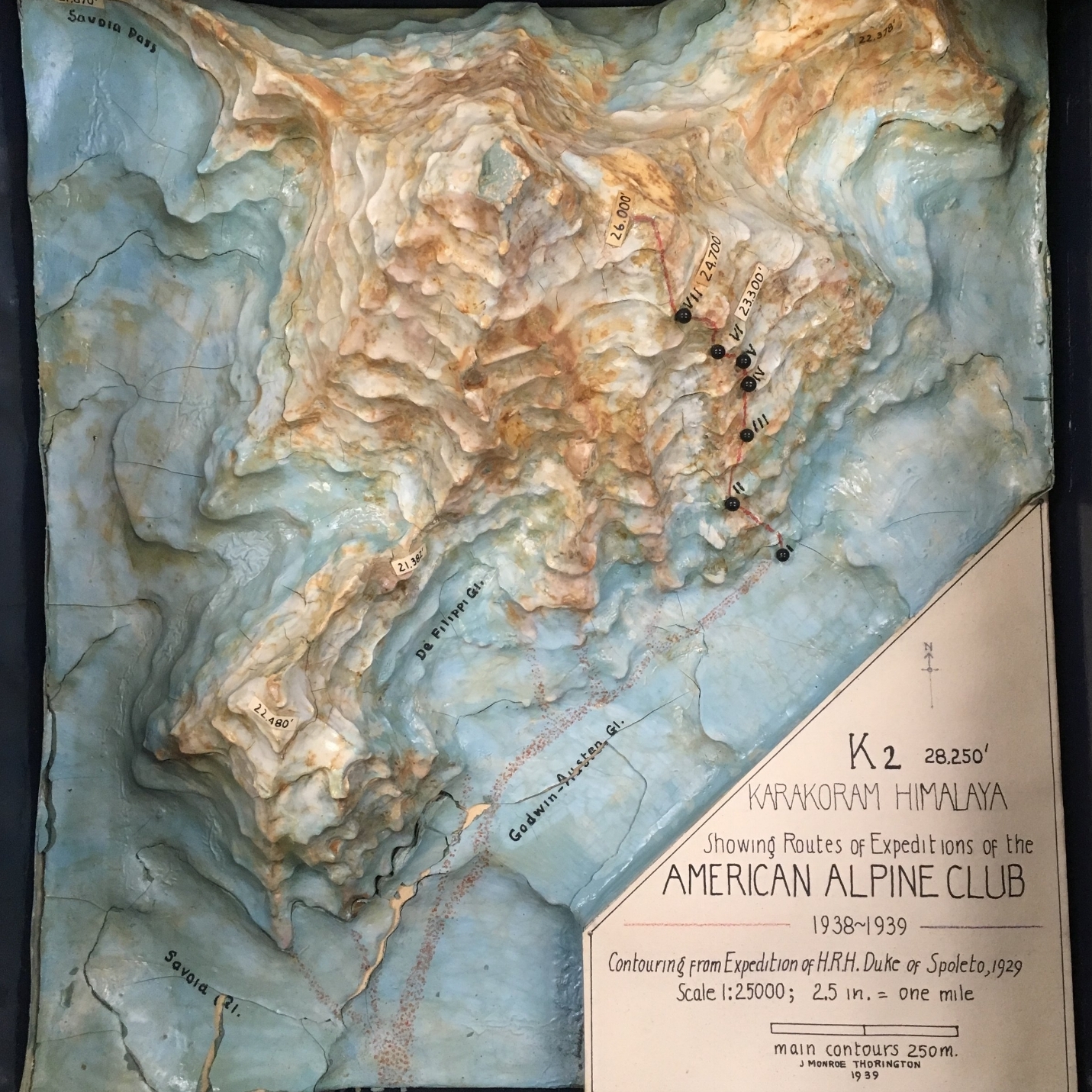
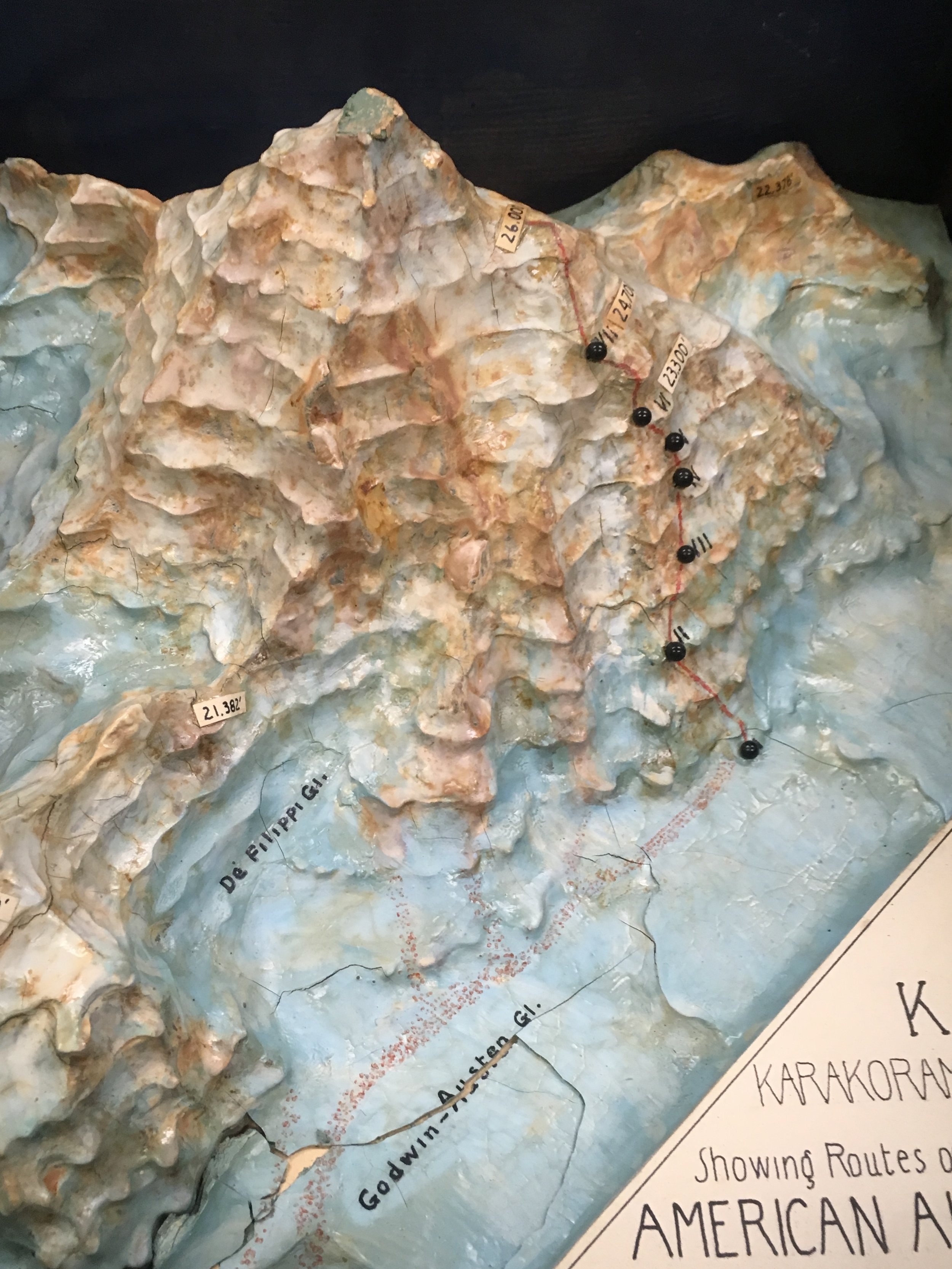
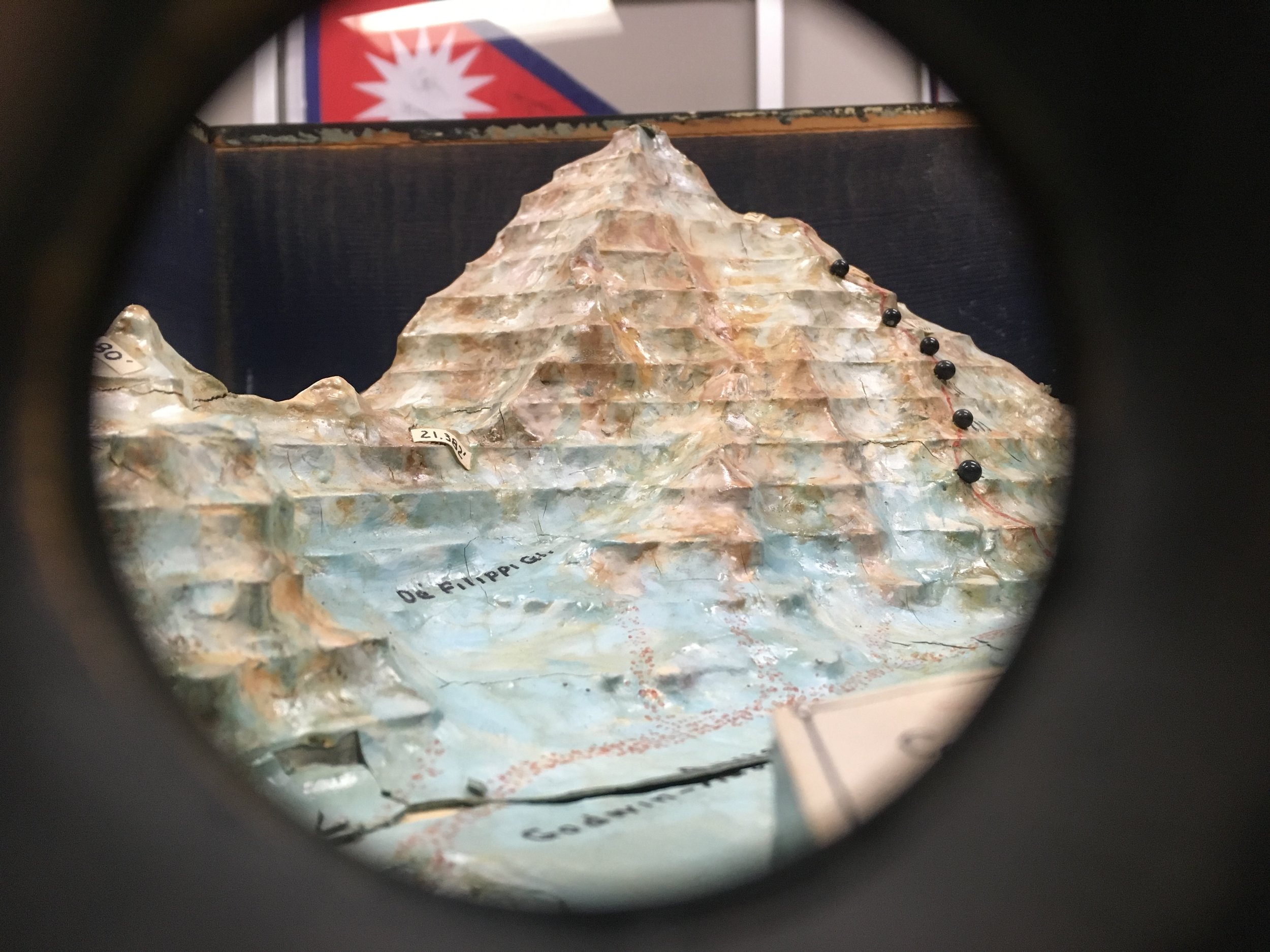
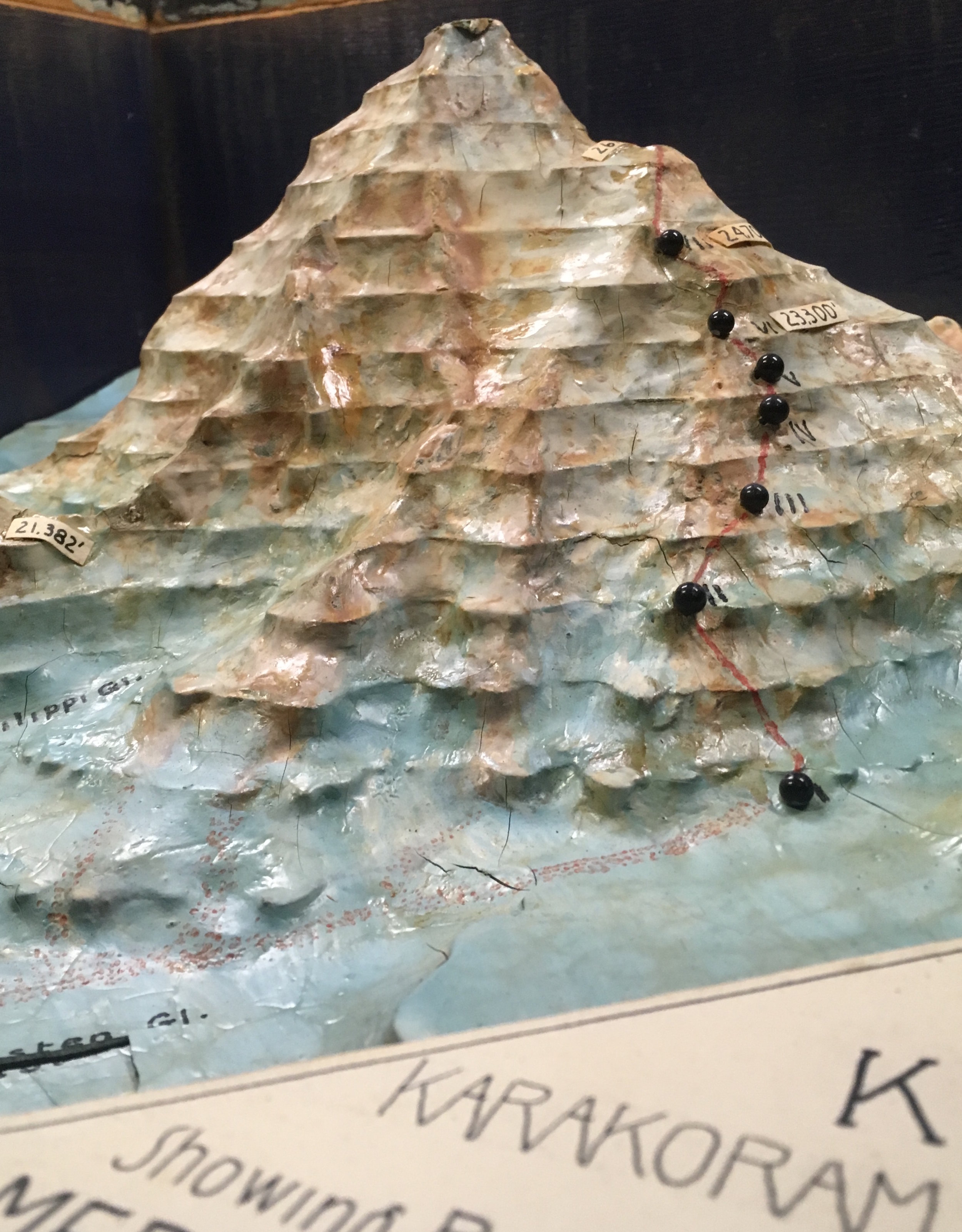
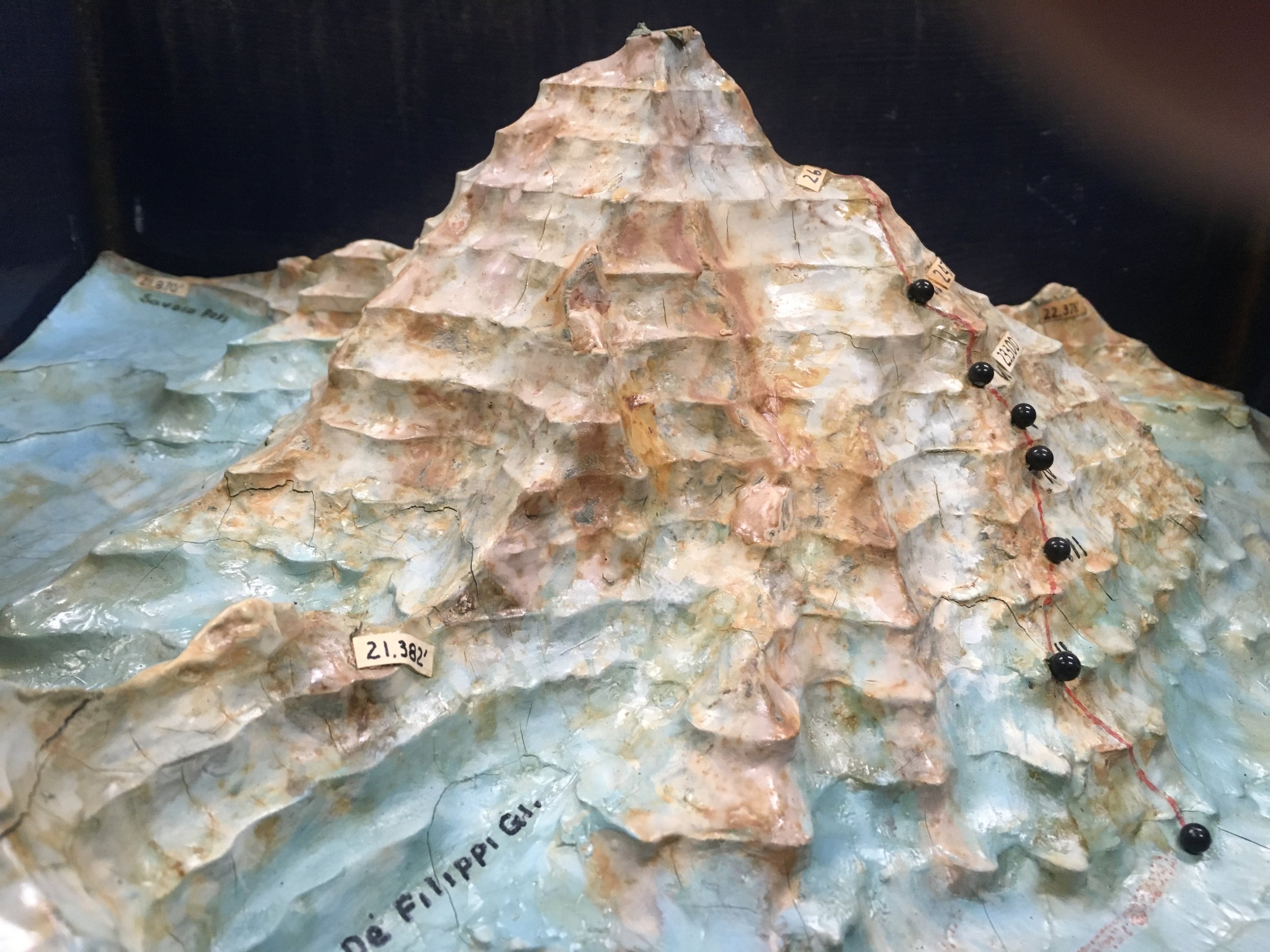
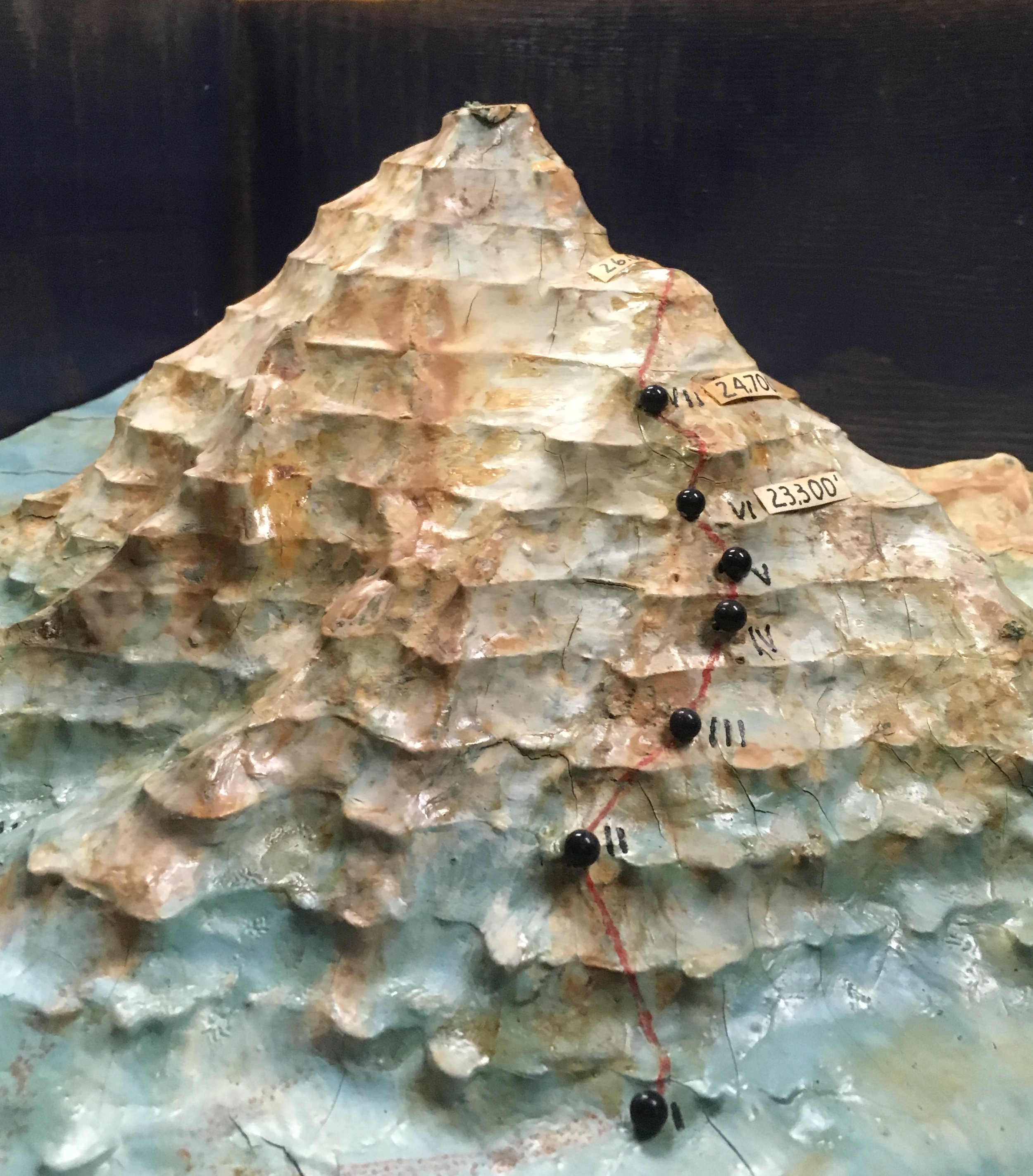
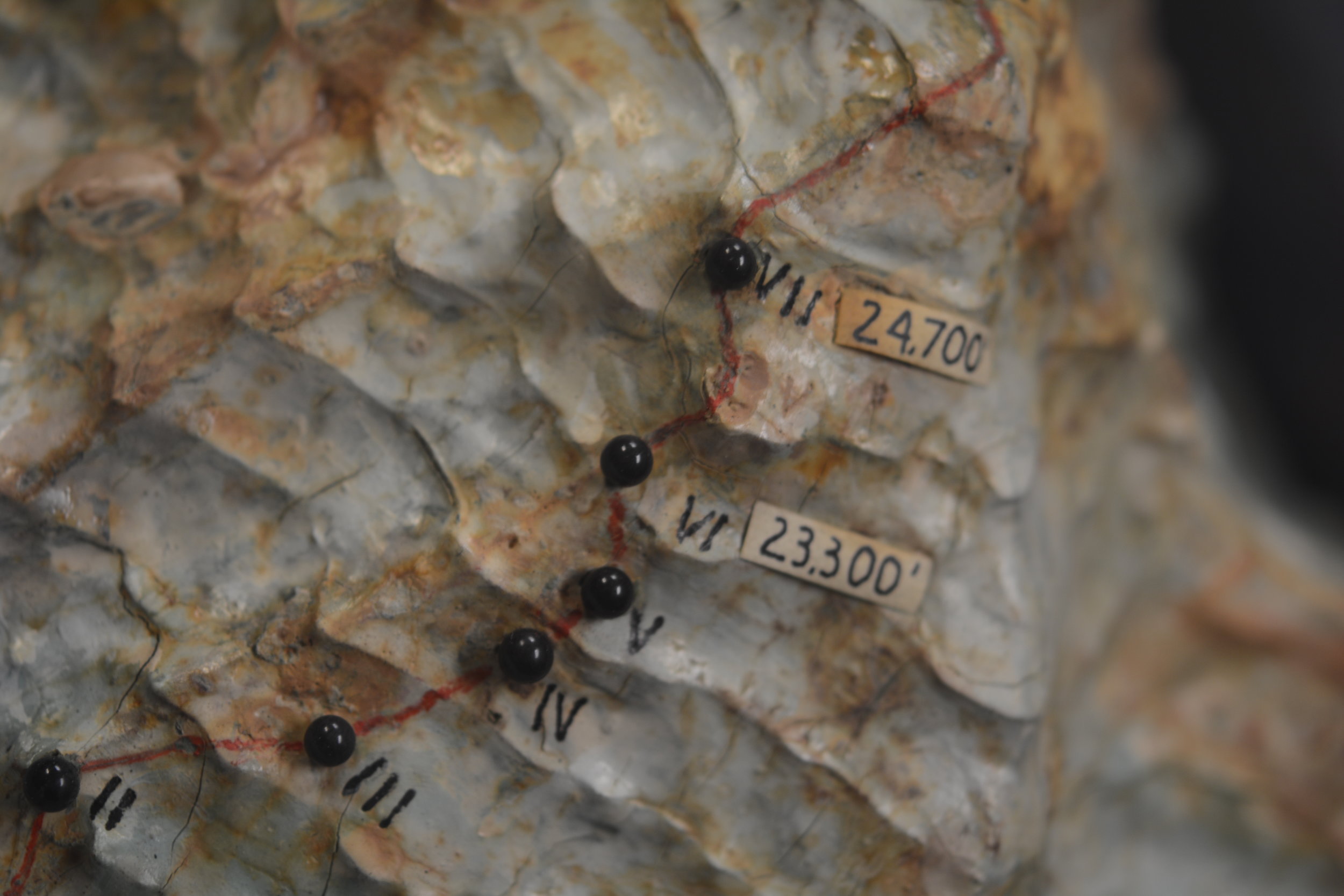
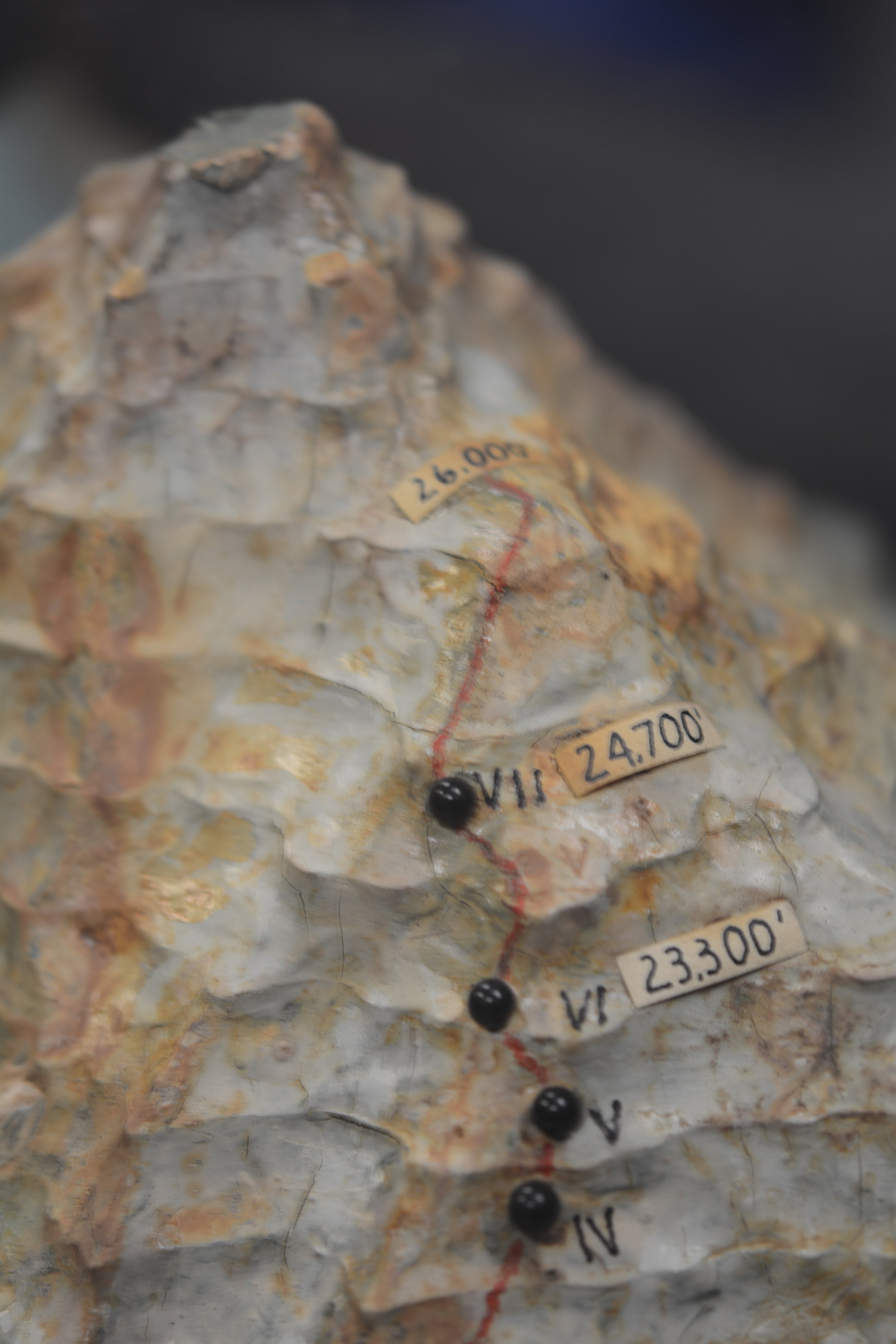
Though their high point of 26,000 ft. was 2,250 ft. below the summit, the First American Karakoram Expedition was a success. The entire south side of the mountain was reconnoitered and a promising route to the summit was discovered. More importantly there were no major injuries and everyone involved survived the attempt high up the Savage Mountain. It was now up to the Second American Karakoram Expedition to climb the mountain.
Read about the Second American Karakoram Expedition here.
Read about the Third American Karakoram Expedition here.
By Eric Rueth
Magic Lantern Slides
A Lantern Slide Close-Up. Caption reads: Climbing Mt. Lyell, Yosemite Nat. Pk. (Photo by Farquar). This slide came from Francis P. Farquhar. It is probably from the 1910-20s.
The magic lantern was an early type of image projection, used since the 17th century, to show painted or printed materials for entertainment. With the invention of the photograph, it was adapted in the 19th century to project photographic materials to the masses.
Mountaineers would often employ this method to illustrate lectures on their mountain pursuits. Many of the early American Alpine Club annual dinners included lectures and talks that were "illustrated by lantern views."
Excerpt from the 1911 By-Laws & Register Book: Notes from the Eighth Annual Meeting held in Boston, 1909
Lantern slide projectors are the apparatus used to display the images. We have three in the AAC Library. They are currently on exhibit (until February 2018) in the American Mountaineering Center.
On display at the American Mountaineering Center in Golden, Colorado (until Feb. 2018).
These projectors date from approximately 1900 to 1930s. A 1950s slide projector is also on display with a 35mm glass slide. The many glass lantern slides on display date from 1890-1950. Most are from the American Alpine Club Archives, with a few from the Colorado Mountain Club Archives. You can see mountain scenes, cabins, and instructional slides.
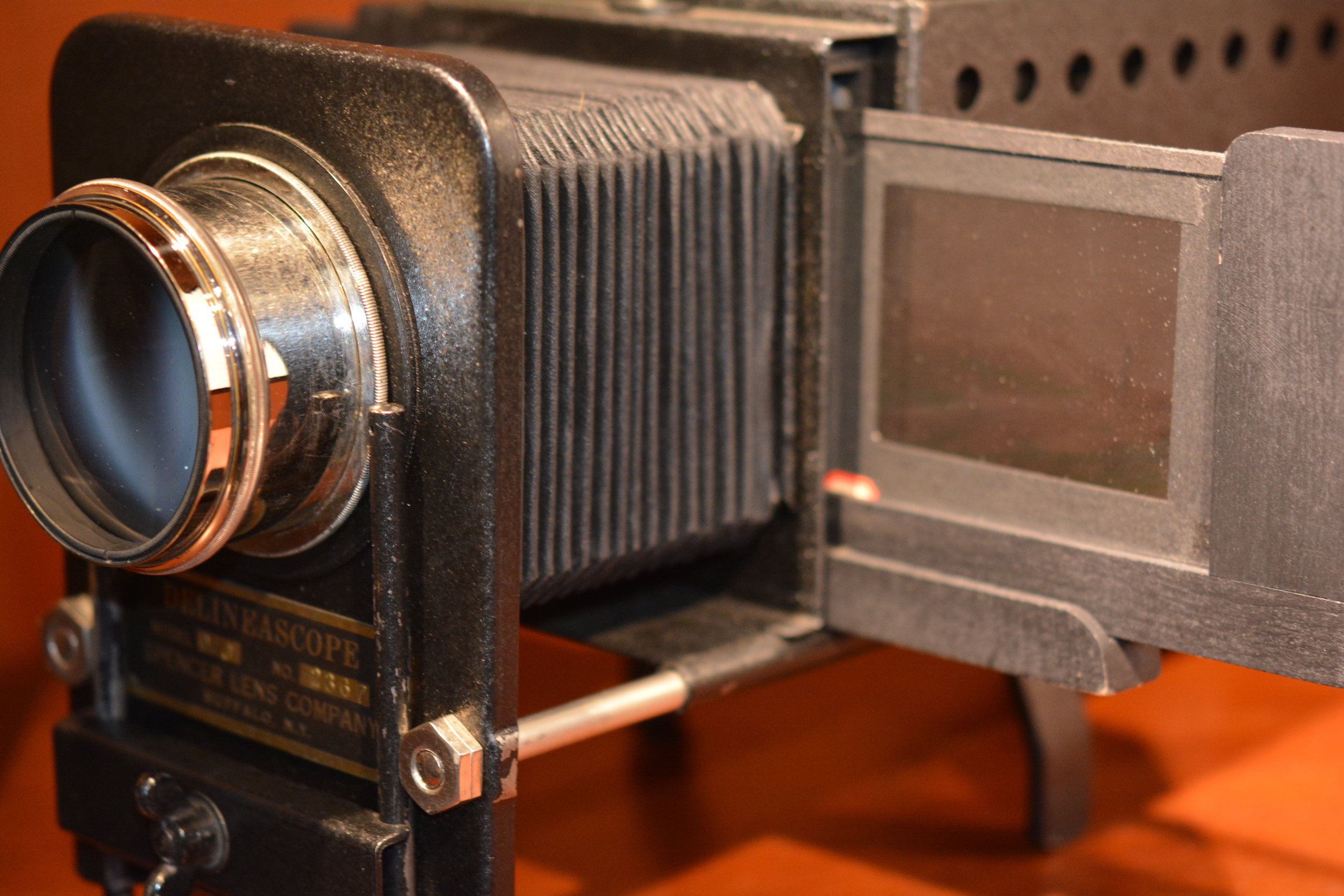
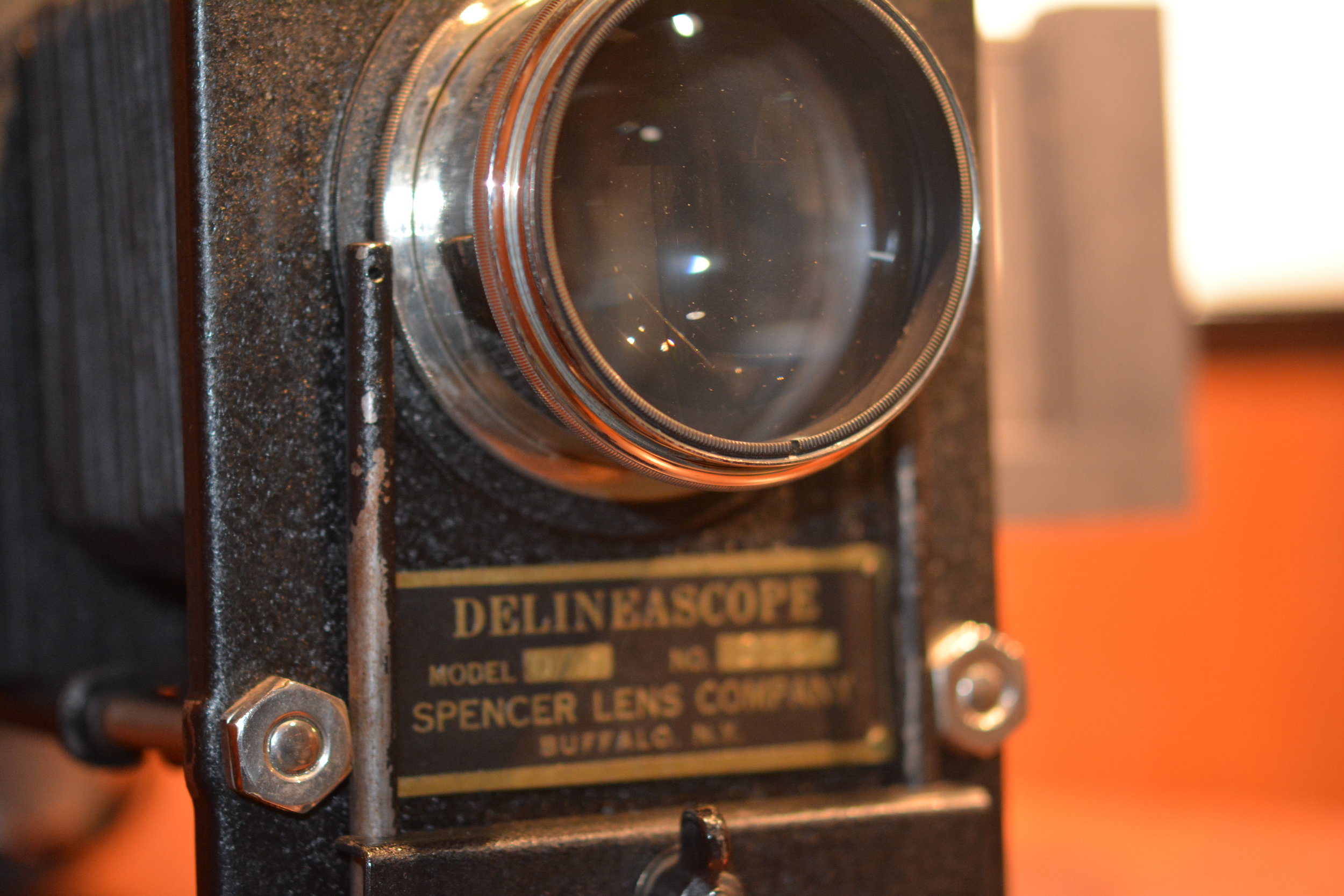
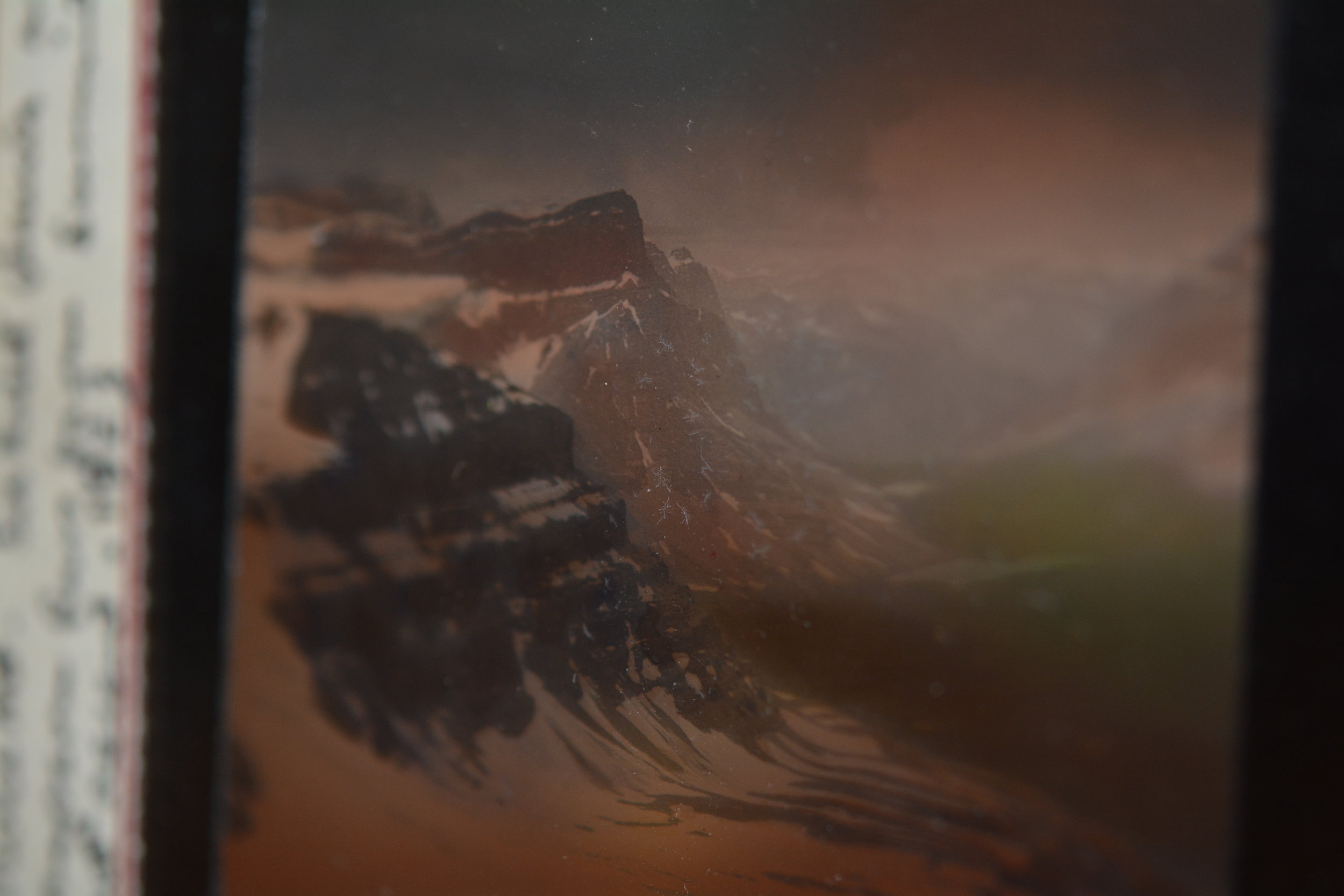
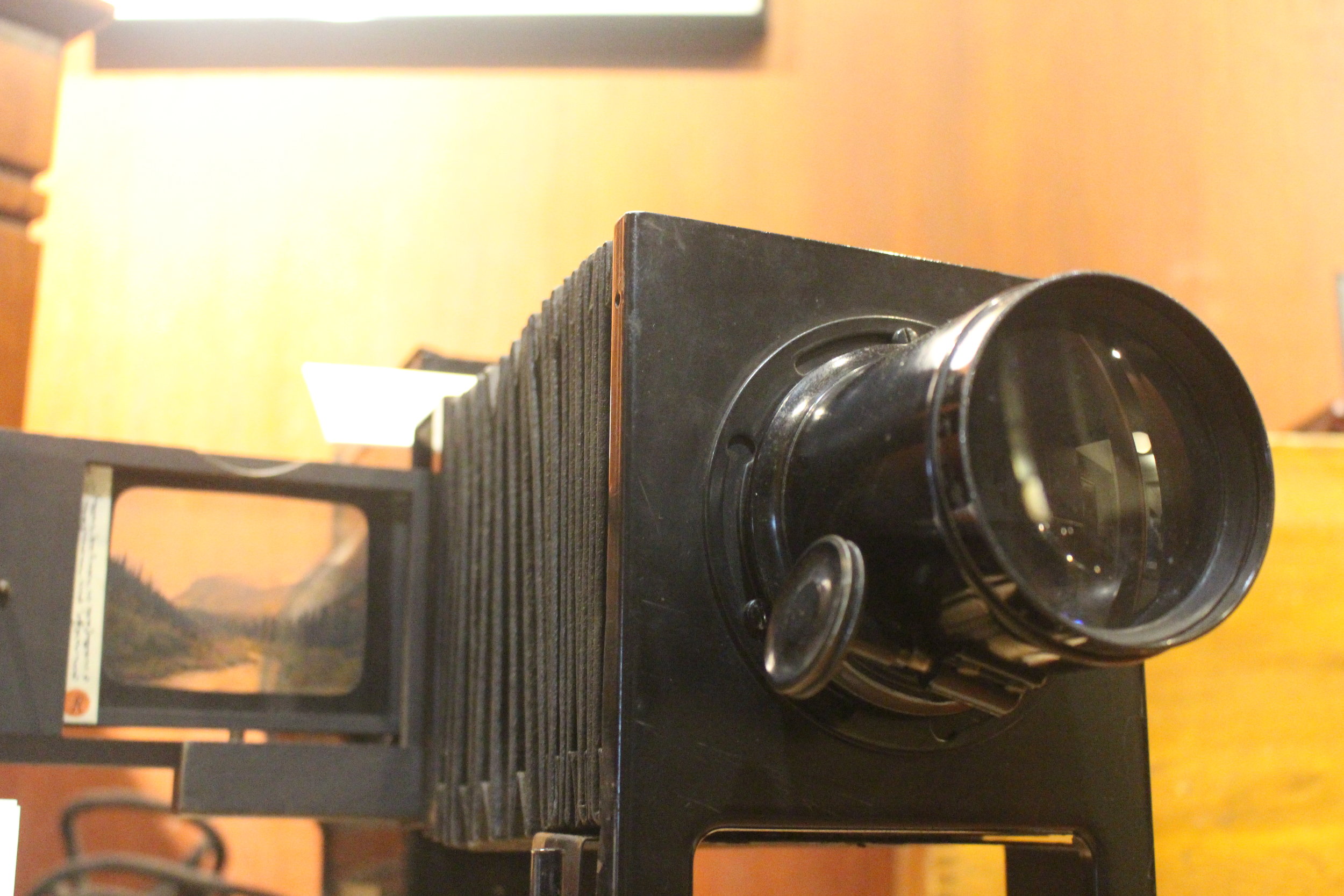
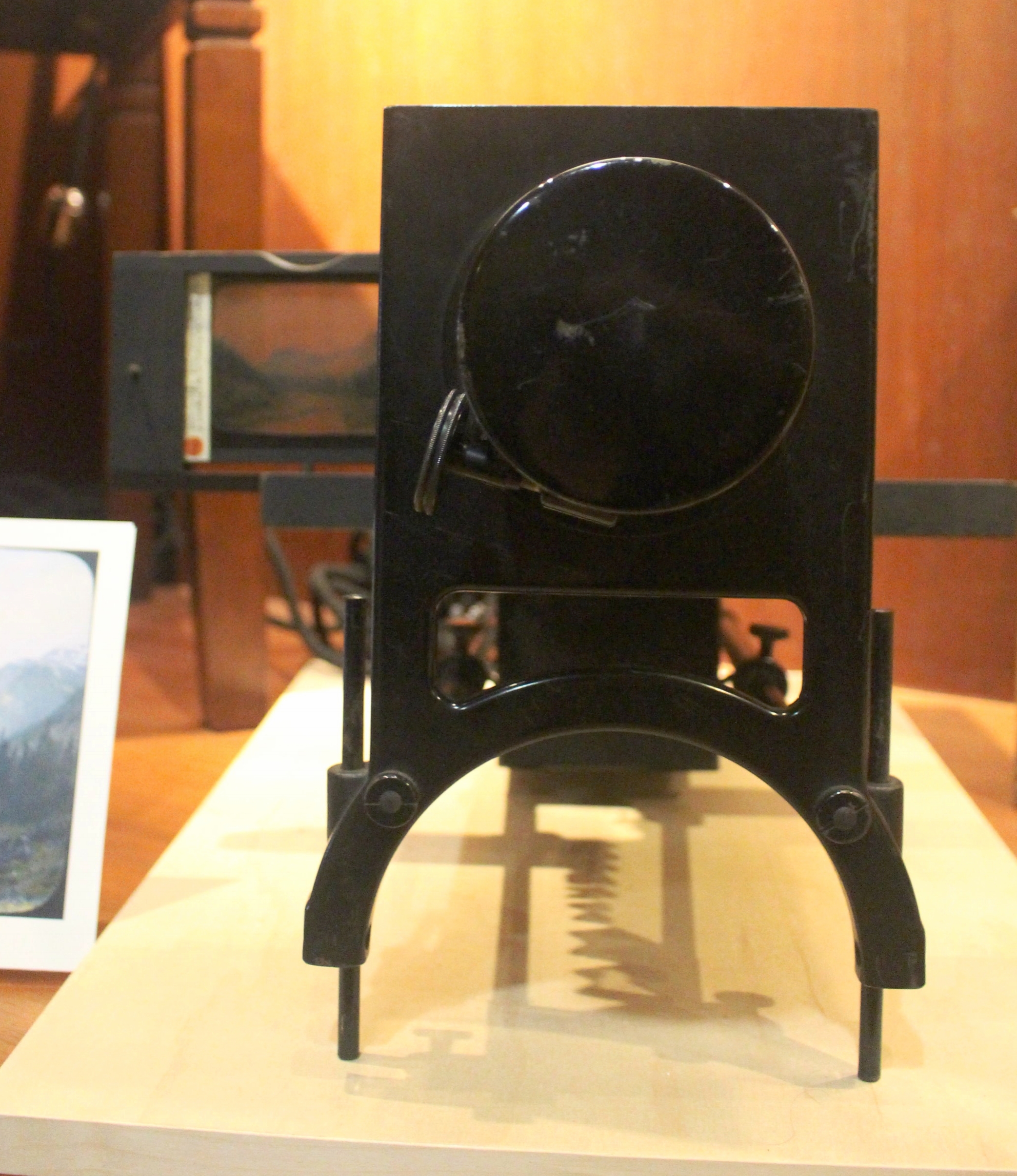
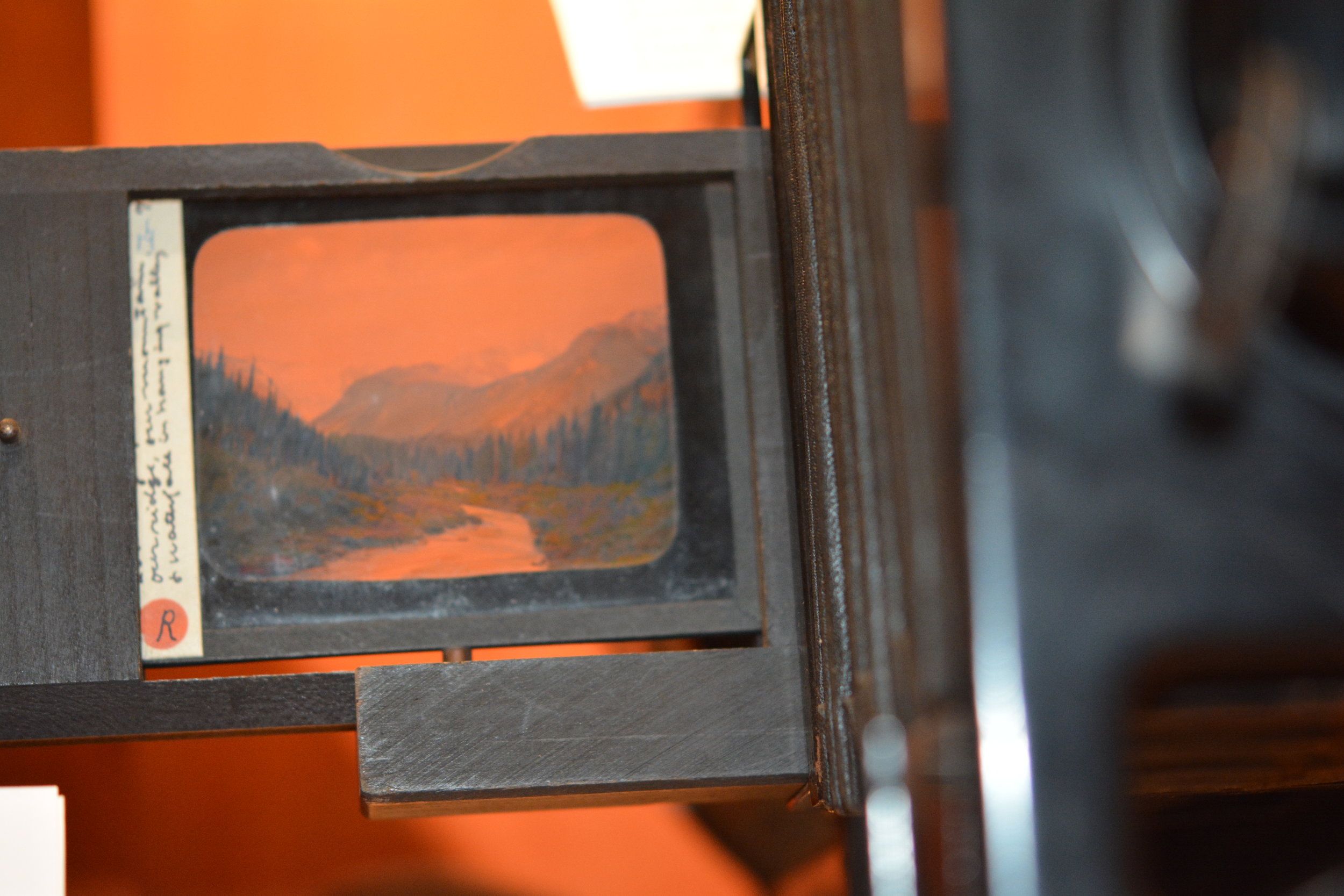
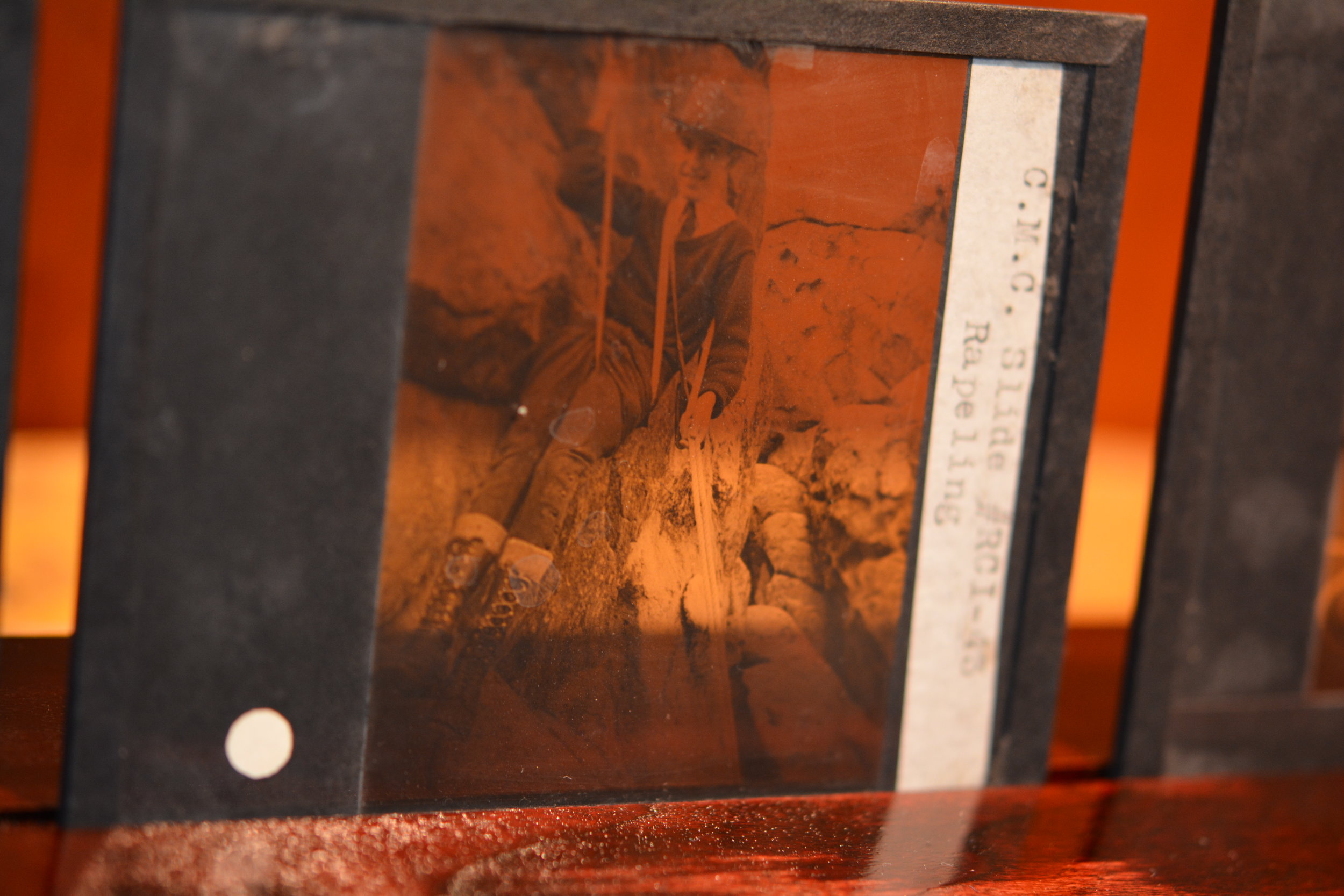
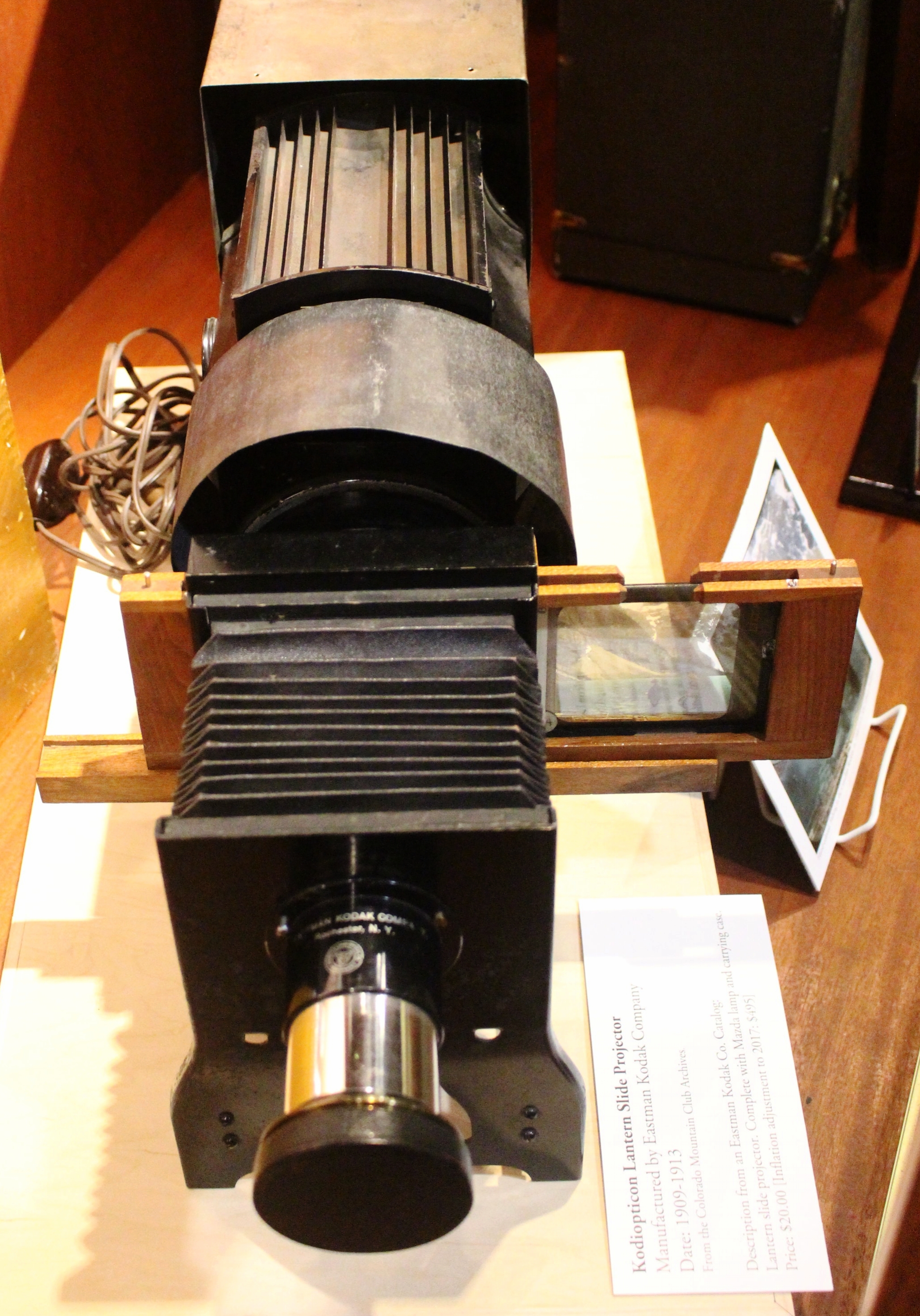
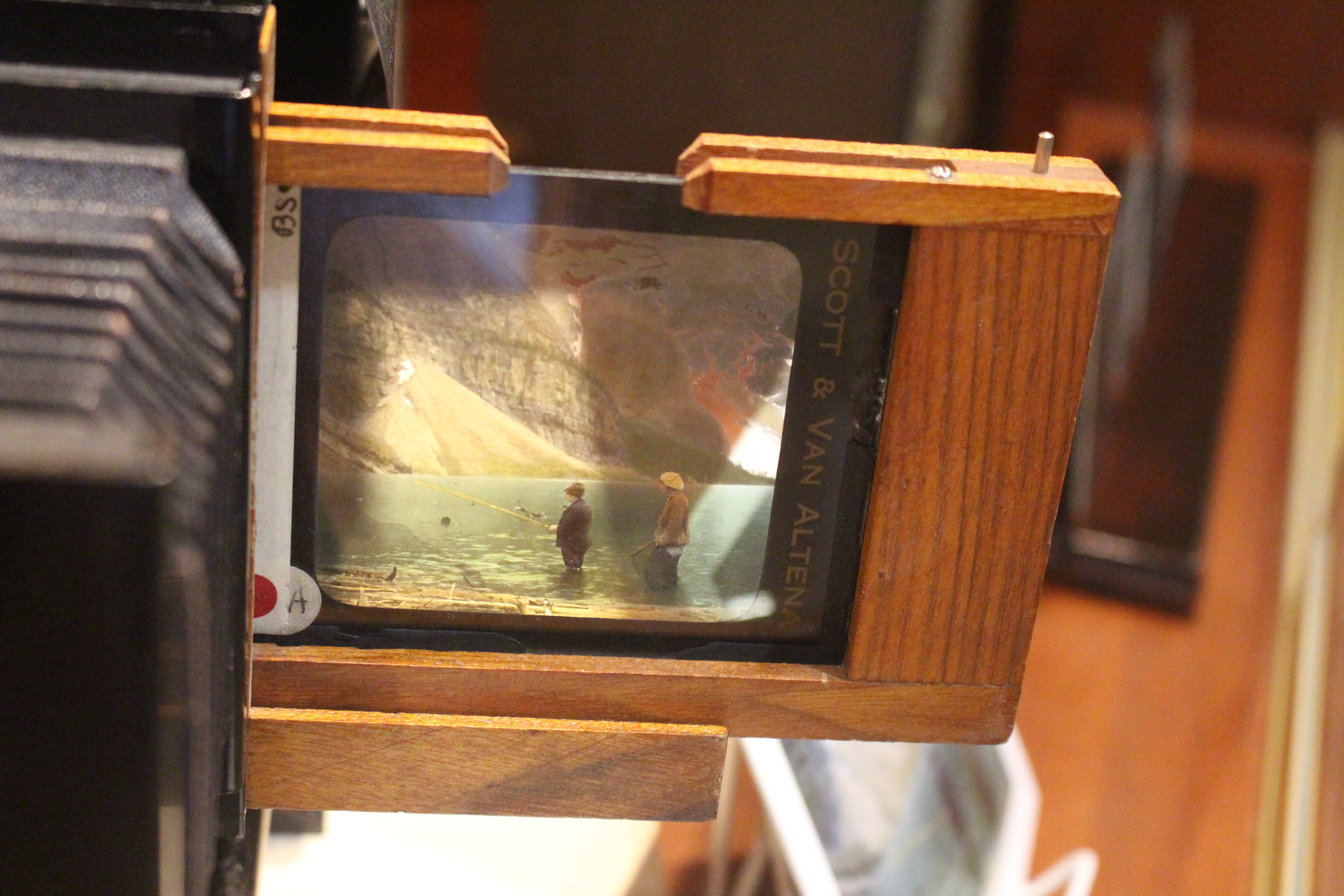
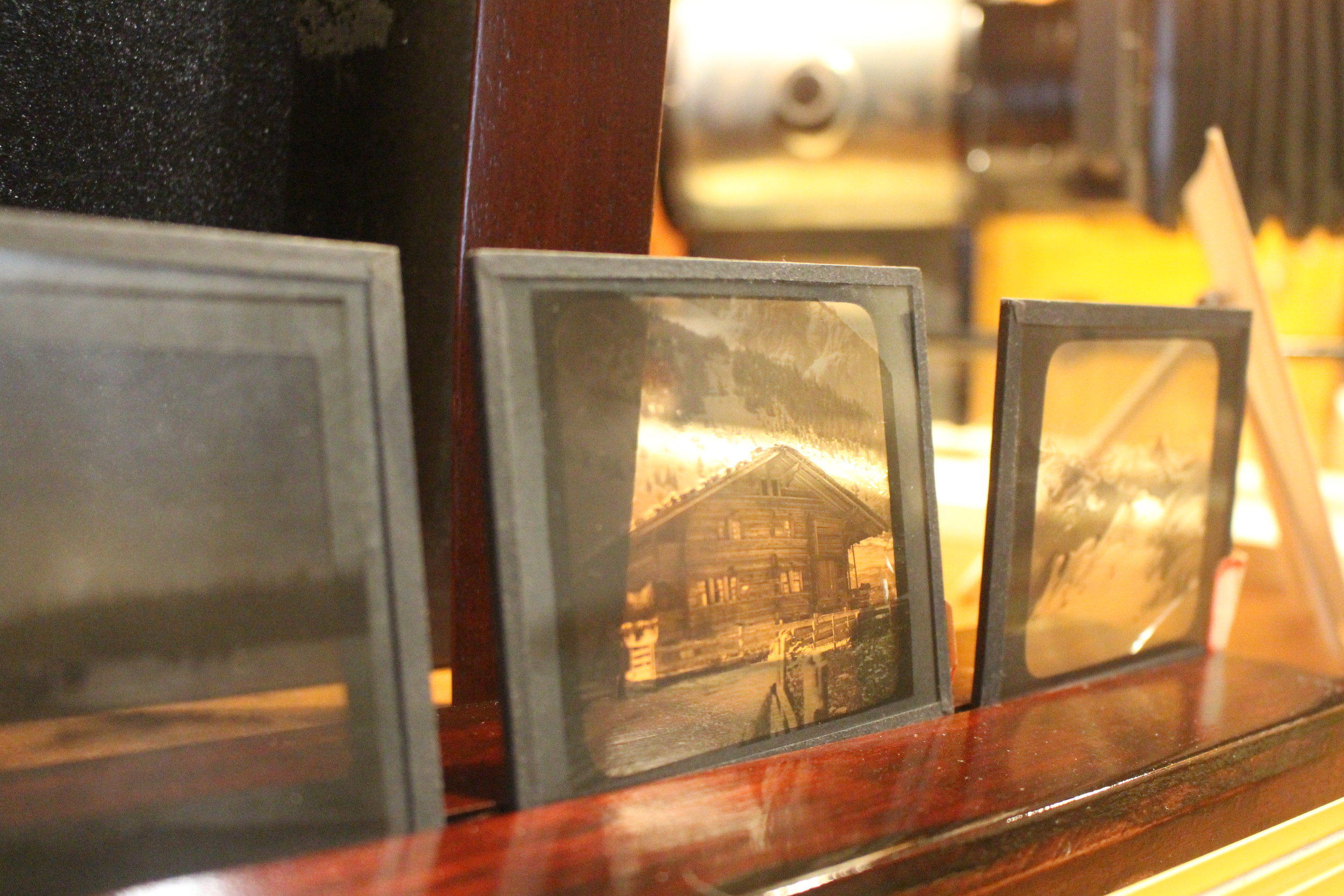
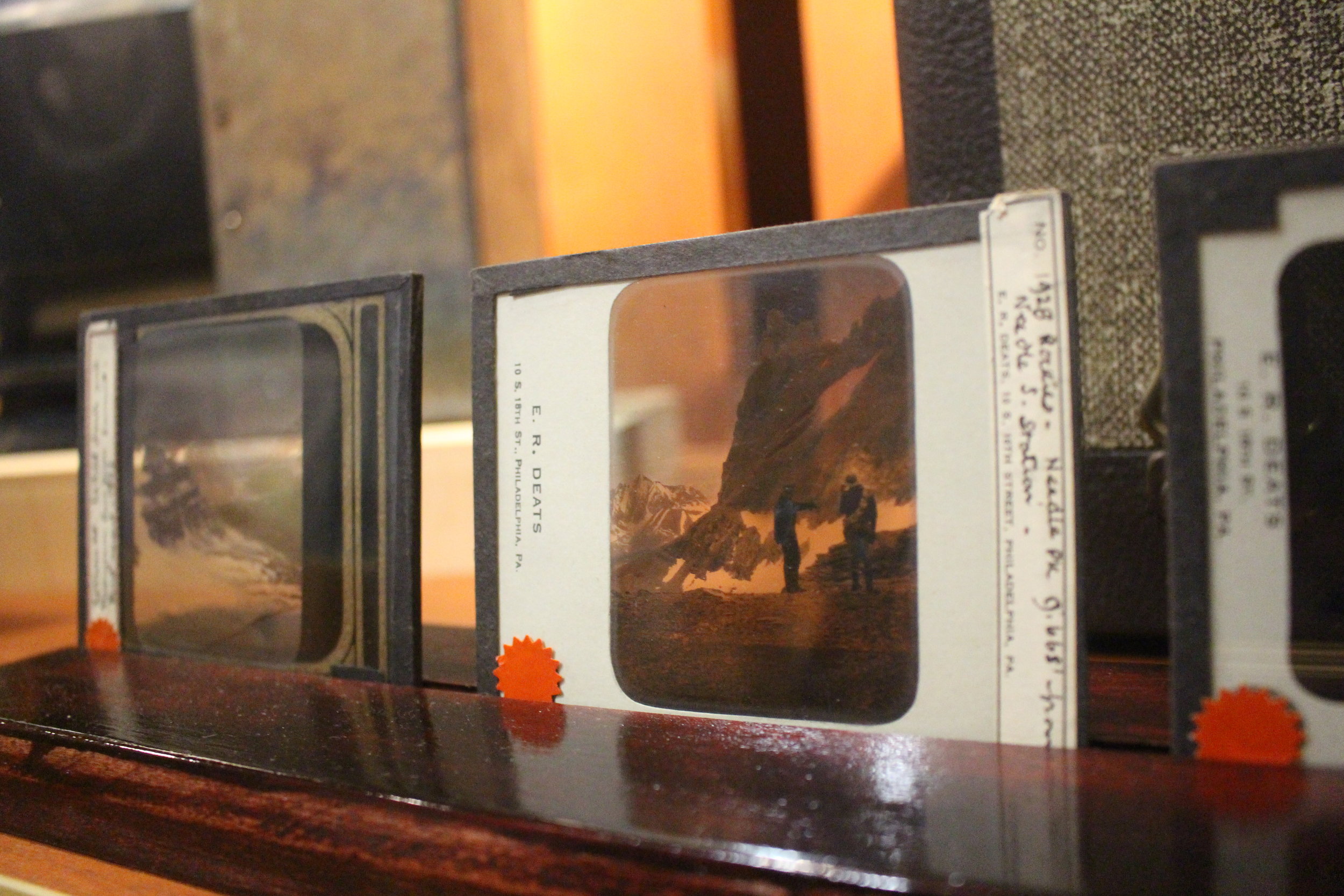

This is one of the projectors in our collection. This page is from a 1911 Bausch & Lomb catalog, which can be viewed in its entirety here on HathiTrust.



